HTC GL PDA User Manual Galaxy Generic Manual English Book indb
HTC Corporation PDA Galaxy Generic Manual English Book indb
HTC >
Users Manual

User Manual

2 |
Please Read Before Proceeding
Microsoft, MS-DOS, Windows, Windows NT, Windows Server, Windows Mobile,
ActiveSync, Excel, Internet Explorer, MSN, Outlook, PowerPoint, and Word are
either registered trademarks or trademarks of Microsoft Corporation in the United
States and/or other countries.
THIS DEVICE IS NOT CHARGED WHEN YOU TAKE IT OUT OF THE BOX.
DO NOT REMOVE THE BATTERY PACK WHEN THE DEVICE IS CHARGING.
YOUR WARRANTY IS INVALIDATED IF YOU OPEN OR TAMPER WITH THE
DEVICE’S OUTER CASING.
EXPLOSIVE ATMOSPHERES
When in any area with a potentially explosive atmosphere or where
flammable materials exist, the product should be turned off and the
user should obey all signs and instructions. Sparks in such areas
could cause an explosion or fire resulting in bodily injury or even death.
Users are advised not to use the equipment at refueling points such
as service or gas stations, and are reminded of the need to observe
restrictions on the use of radio equipment in fuel depots, chemical
plants, or where blasting operations are in progress. Areas with a
potentially explosive atmosphere are often, but not always, clearly
marked. These include fueling areas, below deck on boats, fuel or
chemical transfer or storage facilities, and areas where the air contains
chemicals or particles, such as grain, dust, or metal powders.

| 3
Important Safety Precautions
When using this product, the safety precautions below must be taken to offset
possible legal liabilities and damages.
ELECTRICAL SAFETY
This product is intended for use when supplied with power from
the battery.
Other usage may be dangerous and will invalidate any
approval given to this product.
SAFETY IN AIRCRAFTS
Due to the possible interference caused by this product to an aircraft's
navigation system and its communications network, using this product
on board an airplane is against the law in most countries.
ENVIRONMENT RESTRICTIONS
Do not use this product at gas or refueling stations. The use of this
product is also prohibited in fuel storehouses, chemical plants, and
locations containing explosives.
SAFETY FOR ENVIRONMENTS
Do not use this product in gas stations, fuel depots, chemical plants or
where blasting operations are in progress, or in potentially explosive
atmospheres such as fuelling areas, below deck on boats, fuel or
chemical transfer or storage facilities, and areas where the air contains
chemicals or particles, such as grain, dust, or metal powders. Please
be aware that Sparks in such areas could cause an explosion or fire
resulting in bodily injury or even death.
ROAD SAFETY
Vehicle drivers in motion are not permitted to use telephony services
with handheld devices, except in the case of emergency. In some
countries, using hand-free devices as an alternative is allowed.

4 |
INTERFERENCE WITH MEDICAL EQUIPMENT FUNCTIONS
This product may cause medical equipment to malfunction. The use of
this device is forbidden in most hospitals and medical clinics.
NONIONIZING RADIATION
This product should be operated in the suggested normal condition
only to ensure the radiative performance and safety of the interference.
As with other mobile radio transmitting equipment, users are advised
that for satisfactory operation of the equipment and for the safety
of personnel, it is recommended that no part of the human body be
allowed to come too close to the antenna during operation of the
equipment.

| 5
Contents
Chapter 1 Getting Started
1.1 Getting to Know your Device andits Accessories .... 10
1.2 Battery Information ..................................................... 15
1.3 Starting Up ................................................................... 17
1.4 The Today Screen ........................................................ 19
1.5 Indicators ..................................................................... 20
1.6 Using the Start Menu ................................................... 23
Chapter 2 Entering and Searching Information
2.1 Introduction .................................................................. 26
2.2 Using the Standard On-Screen Keyboard ................. 26
2.3 Recording a Note ......................................................... 27
2.4 Searching Information ................................................ 28
Chapter 3 Synchronizing Your Pocket PC
3.1 Using ActiveSync ........................................................ 30
3.2 Synchronizing Information ......................................... 31
3.3 Synchronizing via Infrared and Bluetooth ................ 34
3.4 Synchronizing Music, Video, and Pictures ............... 35

6 |
Chapter 4 Managing Your Pocket PC
4.1 Personalizing Your Pocket PC ................................... 38
4.2 Adding and Removing Programs ............................... 45
4.3 Managing Memory ....................................................... 47
4.4 Backing Up Files ......................................................... 48
4.5 Protecting Your Device ............................................... 50
4.6 Resetting Your Pocket PC .......................................... 52
Chapter 5 Getting Connected
5.1 Using Wireless Connection ........................................ 54
5.2 Connecting to the Internet .......................................... 56
5.3 Internet Explorer Mobile ............................................. 58
5.4 Using Bluetooth ........................................................... 61
5.5 Using Terminal Services Client .................................. 66
Chapter 6 Exchanging Messages
and Using Outlook
6.1 E-mail and Text Messages .......................................... 70
6.2 Pocket MSN .................................................................. 76
6.3 Calendar ....................................................................... 78
6.4 Contacts ....................................................................... 80
6.5 Tasks ............................................................................. 82
6.6 Notes ............................................................................ 84

| 7
Chapter 7 Experiencing Multimedia
7.1 Using Pictures & Videos ............................................. 88
7.2 Using Windows Media Player ..................................... 93
Chapter 8 Using Other Applications
8.1 Word Mobile ............................................................... 102
8.2 Excel Mobile ............................................................... 104
8.3 Viewing Slide Shows withPowerPoint Mobile ........ 106
Appendix
A.1 Regulatory Notices .....................................................110
A.2 PC Requirement to Run ActiveSync 4.x ...................116
A.3 Specifications ............................................................116
A.4 Index ............................................................................118

8 |

1.1 Getting to Know your Device
and its Accessories
1.2 Battery Information
1.3 Starting Up
1.4 The Today Screen
1.5 Indicators
1.6 Using the Start Menu
Chapter 1
Getting Started
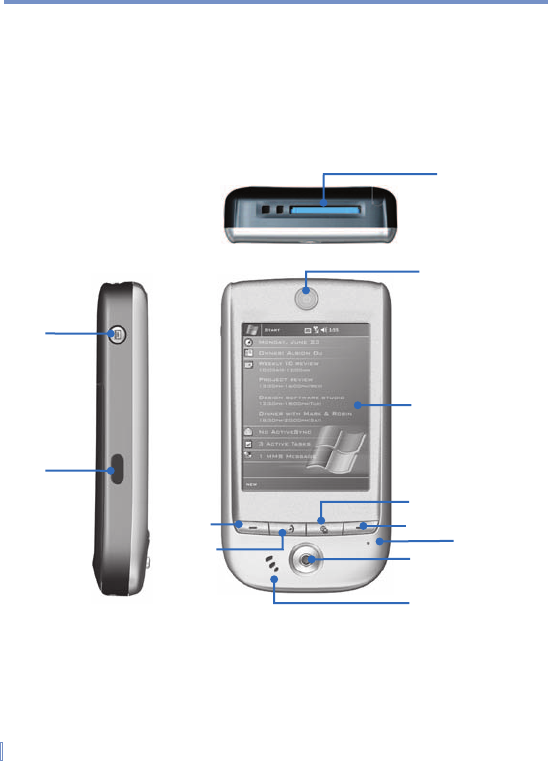
10 | Getting Started
1.1
Getting to Know your Device and
its Accessories
Front, top, and left-side view
4
9
12
8
11
6
7
5
1
2
3
10
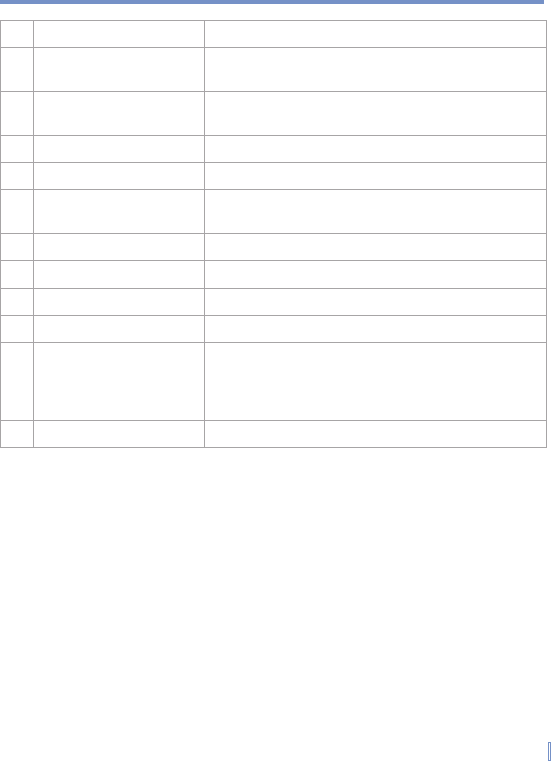
Getting Started | 11
1 Record Press to record a voice note.
2 Infrared Port Enables you to exchange file(s) or data with other
devices without calbles/wires.
3 MMC card or SDIO
accessories Slot
Insert either MMC card or SDIO accessories in this
slot.
4 Power/Backlight Press to turn on and off your device or backlight.
5 Touch Screen For making a selection with the stylus.
6 Calendar/Left Soft Key Press for quick Calendar access and perform the
command shown in the label above the button.
7 GPS Launch Key Press to start GPS system in your pocket PC.
8 Today Screen Press anytime to go back to Today screen.
9 Contact/Right Soft Key Press for quick acess to your contacts.
10 Microphone Speak here when recording voice.
11 Navigation Pad Press this multi-directional control up, down, left, or
right to move through menus, program instructions;
carry out the selection by pressing the center button
as ENTER key.
12 Speaker Listen to audio media here.
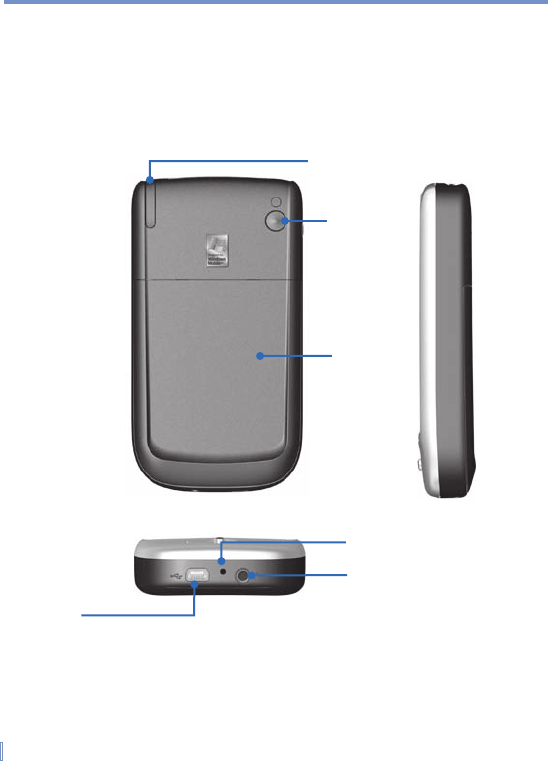
12 | Getting Started
Back, and bottom view
14
15
13
18
17
16
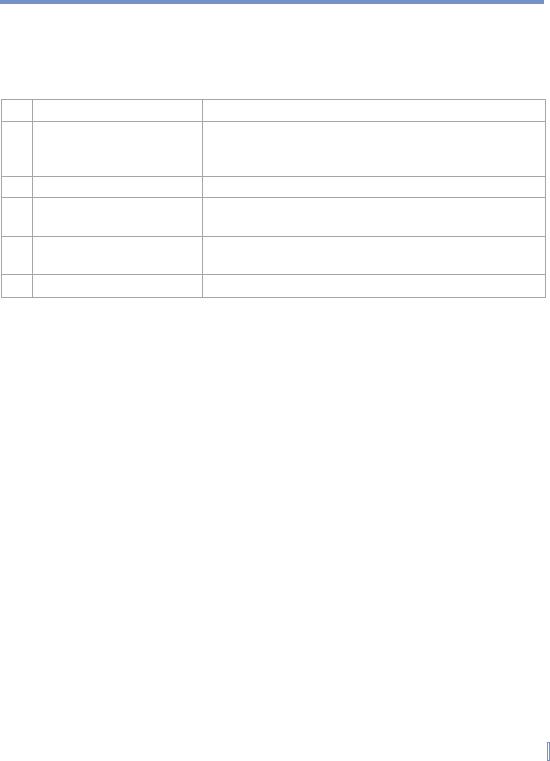
Getting Started | 13
13 Stylus and Stylus Slot
14 GPS Antenna If available, you can attach your device to its antenna
and utilize its superior reception quality for GPS
signal.
15 Back Cover
16 Sync Connector Use this connector for synchronizing data or
recharging the battery.
17 Soft Reset Press into the hole with the stylus to reset your
device.
18 Earphone Jack Allows you to listen to audio media.
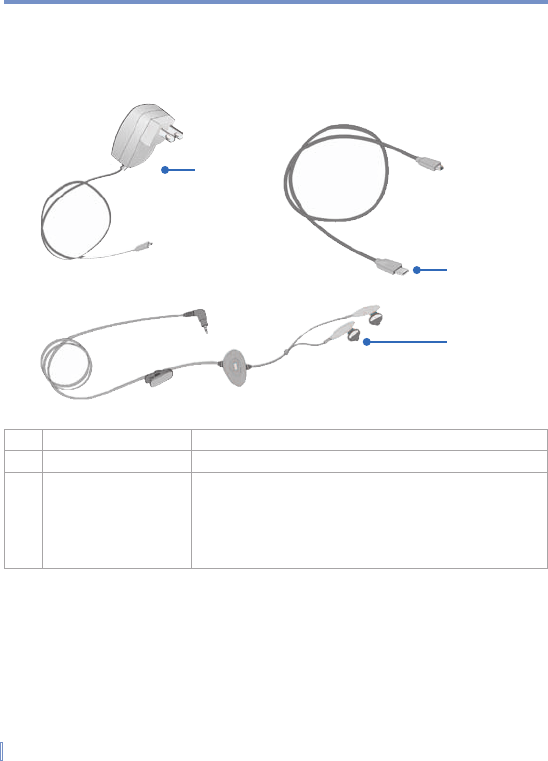
14 | Getting Started
Accessories
The following accessories are provided with the device:
19 AC adapter Recharge the device battery.
20 USB cable Connect your device to a PC and synchronize data.
21 Stereo-wired
headset with volume
control jog dial
Use when listening to music or playback of media files.
19
21
20

Getting Started | 15
1.2 Battery Information
Your device contains a rechargeable Li-ion polymer battery. Your
device is designed to use only manufacturer-specified original batteries
and accessories. Battery
performance depends on many factors,
including your wireless service provider’s network configuration, signal
strength, the temperature of the environment in which you operate your
device, the features and/or settings you select and use, items attached
to your device’s connecting ports, and your voice, data, and other
program usage patterns.
Battery life estimates (approximations):
•
GPS mode: > Up to 5 hours:
•
Standby time: Up to 200 hours
•
WMV playback: 8 hours
•
WMA playback: 12 hours
•
Battery recharge time: Less than 4 hours
Warning! To reduce risk of fire or burns.
•
Do not attempt to open, disassemble, or service the battery pack.
•
Do not crush, puncture, short external contacts, or dispose of in fire
or water.
•
Do not expose to temperatures above 60˚C (140˚F).
•
Replace only with the battery pack designated for this product.
•
Recycle or dispose of used battery as stipulated by local regulation.
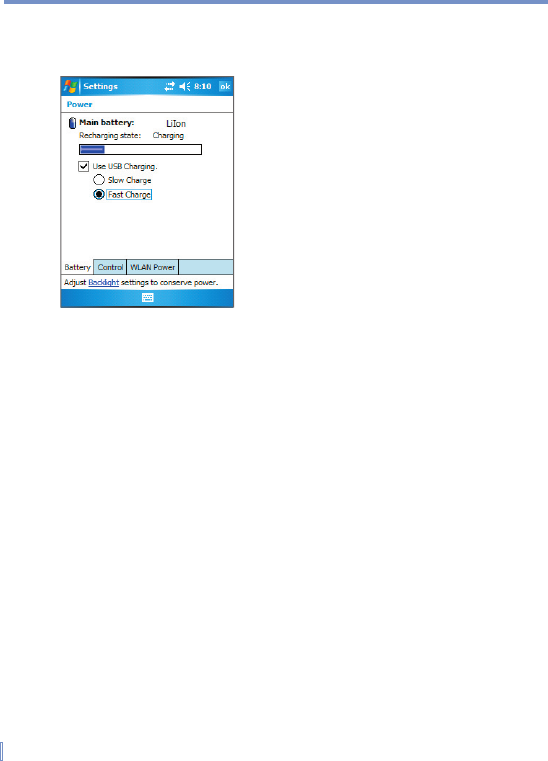
16 | Getting Started
To check the battery power
•
Tap
Start
>
Settings
>
System
tab >
Power
.
Power Information
Charge the battery
New batteries are shipped partially charged. Before you can use your
device, you need to install and charge the battery. Some batteries
perform best after several full charge/discharge cycles. You can charge
the battery by:
•
Connecting your device directly to an external power source.
•
Plugging the device sync cable into the USB port on your PC.
Low battery
When the low-battery warning appears, do the following:
1.
Immediately save your current data.
2.
Synchronize with your PC to charge the battery.
3.
Turn off your device.

Getting Started | 17
1.3 Starting Up
Turn the device on and off
To turn on the device, press the POWER button. When you turn on
the device for the first time, you are asked to complete a calibration
process. For more information, see “Calibrate the device” in this
chapter.
To turn off the device, press POWER again.
Note Pressing POWER turns off your device temporarily and switches
the device to sleep mode. However, you can still receive messages
and calls while your device is in the sleep mode.
Calibrate the Device
Calibrating the device screen involves tapping with the stylus the
center of a cross as it moves around the screen. This process ensures
that when you tap the screen with your stylus, the tapped item is
activated.
If your device does not accurately respond to screen taps, follow these
steps to re-calibrate it:
1.
Tap
Start
>
Settings
>
System
tab >
Screen
.
2.
On the
General
tab, tap
Align Screen
, and follow the instructions
on the screen.
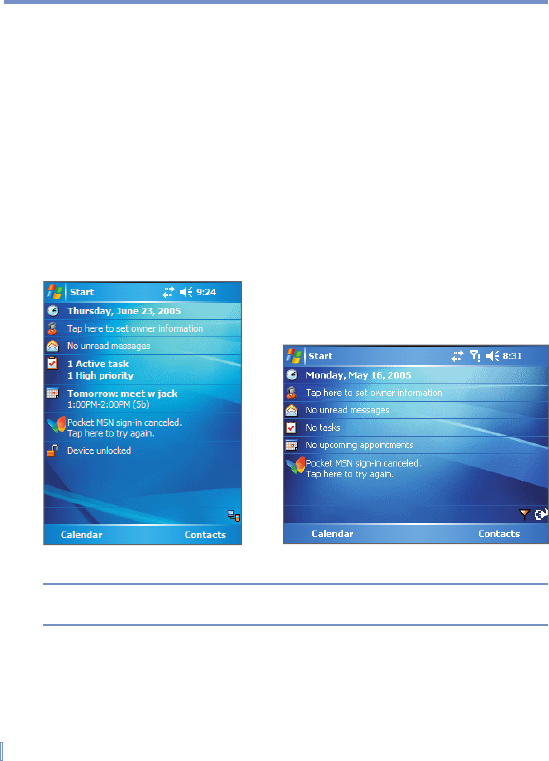
18 | Getting Started
Manage screen settings
The device touch screen has three orientation modes: Portrait,
Landscape (right-handed), and Landscape (left-handed). Portrait
mode allows you to get a better view or a better operation of certain
programs on your device, while Landscape mode may be optimal for
viewing longer text files.
•
To change the orientation, tap
Start
>
Settings
>
System
tab >
Screen
, and select the orientation you want.
•
To smooth the edges of screen fonts for many programs, on the
ClearType
tab, select the
Enable ClearType
check box.
•
To increase the readability or to see more content on the screen,
on the
Text Size
tab, adjust the text size by moving the slider.
Today Screen in Portrait Mode Today Screen in Landscape Mode
Note The screen orientation changes automatically when you open, unfold
and rotate your device.
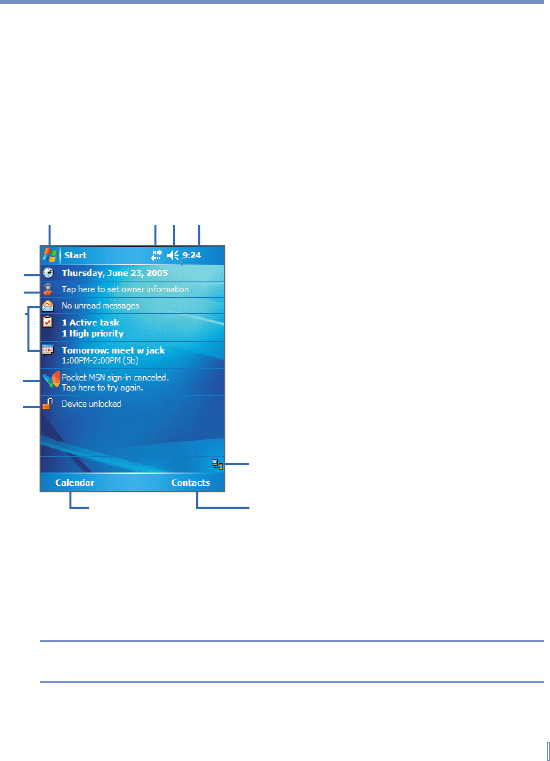
Getting Started | 19
1.4 The Today Screen
The Today screen displays important information, such as upcoming
appointments and status indicators. You can tap a section on the
screen to open the associated program.
•
To access the Today screen, tap
Start
>
Today
.
•
To customize the Today screen display, including the background
image, tap
Start
>
Settings
>
Personal
tab >
Today
.
1Tap to display the items listed in
the Start menu.
2Tap to view connectivity status.
3Tap to control device volume level.
4Tap to see time and next
appointment. Tap and hold to
change time format.
5Displays the synchronization
status between your device and
PC.
6Tap to open the Contacts screen.
7Tap to open your calendar.
8Tap to lock your device.
9Tap to sign-in Pocket MSN
10 Your day at a glance with
reminders. Tap to open the related
program.
11 Tap to set owner information.
12 Tap to change date and time.
12 3
7
10
11
12
4
5
6
Today Screen
8
9
Note You can access the Today screen from anywhere by tapping Start >
Today.
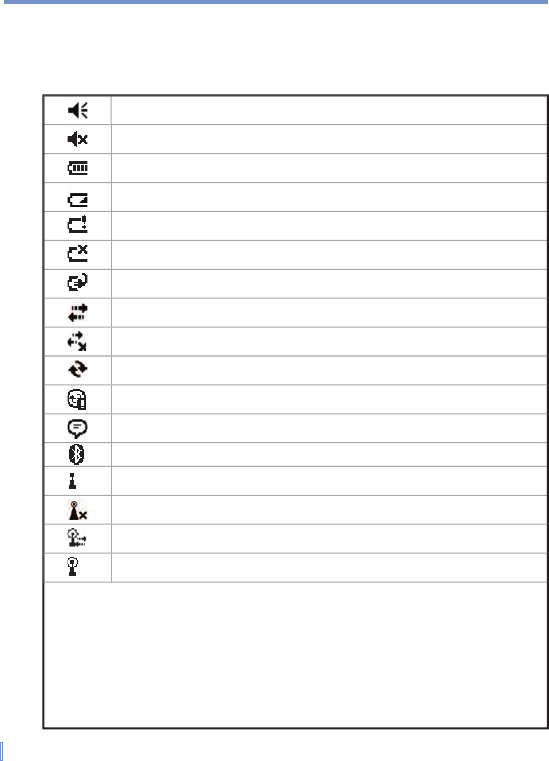
20 | Getting Started
1.5 Indicators
Following are some of the status icons that you may see on your
device.
Sound on & adjusting sound volume
Sound off
Battery level
Main battery low
Main battery very low
Battery empty
Battery charging
Connection is active
Connection is not active
Synchronization in progress
Synchronization error
There are more indicators. Tap the icon to view all.
Bluetooth
Wi-Fi on
Wi-Fi off
Wi-Fi connecting
Wi-Fi connected
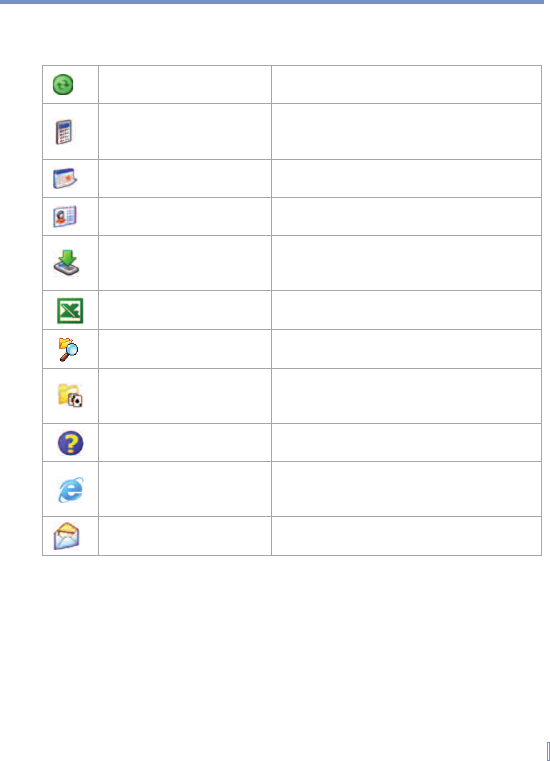
Getting Started | 21
Following are some of the icons for the programs that are already installed
on your device.
ActiveSync
Synchronizes information between your
device and a PC.
Calculator
Performs basic arithmetic and
calculations, such as addition,
subtraction, multiplication, and division.
Calendar
Keeps track of your appointments and
creates meeting requests.
Contacts
Keeps track of your friends and
colleagues.
Download Agent
Provides information about the
download status and the downloaded
content from the Internet.
Excel Mobile
Creates new workbooks or lets you
view and edit Excel workbooks.
File Explorer
Enables you to organize and manage
files on your device.
Games
Lets you play two games; Bubble
Breaker and Solitaire are included in
this folder, by default.
Help
Enables you to see Help topics for a
program on your device.
Internet Explorer
Internet Explorer browses Web and
WAP sites, and downloads new
programs and files from the Internet.
Messaging
Sends and receives e-mail and text
messages.
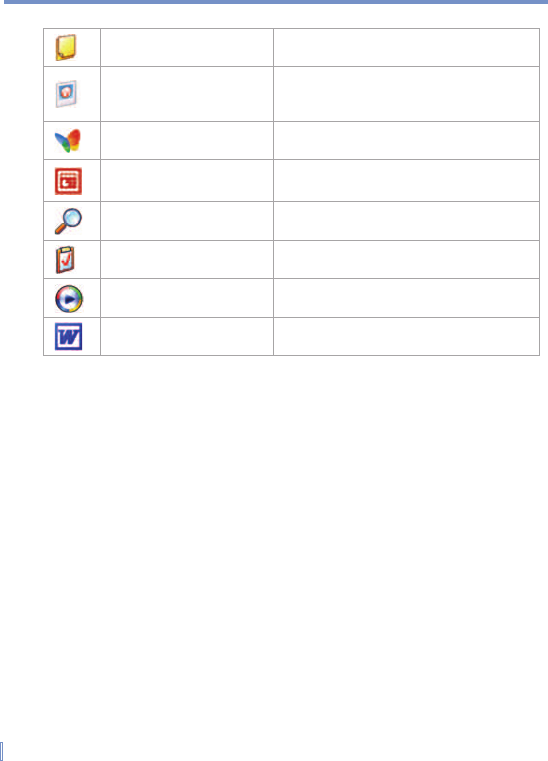
22 | Getting Started
Notes
Creates handwritten or typed notes,
drawings, and recordings.
Pictures & Videos
Collects, organizes, and sorts picture
and video files in the My Pictures folder
of your device or on a storage card.
Pocket MSN
Sends and receives instant messages
with your MSN Messenger contacts.
PowerPoint Mobile
Lets you view and edit PowerPoint
slides and presentations.
Search
Enables you to search contacts, data,
and other information on your device.
Tasks
Keeps track of your tasks.
Windows Media Player
Enables the multimedia function on
your device.
Word Mobile
Creates new documents or lets you
view and edit Word documents.
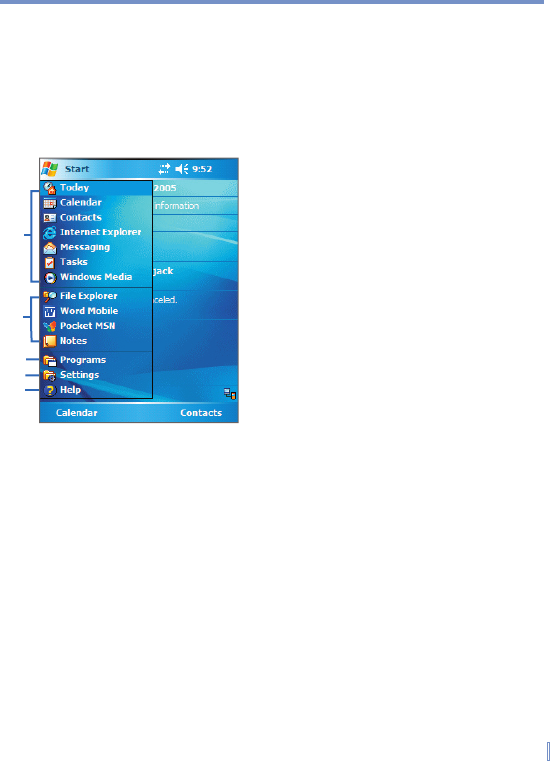
Getting Started | 23
1.6 Using the Start Menu
The Start menu, located at the top left corner of the Today screen,
displays a list of programs. It lets you close a screen and switch from
one program to another. You can start a program by scrolling through
the programs list and then pressing ENTER button or by tapping a
program with the stylus.
1Tap to switch to a program.
2
Tap to switch to a recently-used program.
3Tap to see more programs.
4Tap to change device settings.
5Tap to see a Help topic for the current
screen.
2
1
3
4
5
Start Menu

24 | Getting Started

2.1 Introduction
2.2 Using the Standard On-Screen Keyboard
2.3 Recording a Note
2.4 Searching Information
Chapter 2
Entering and Searching Information

26 | Entering and Searching Information
2.1 Introduction
When you select a field that requires text or numbers, Input Panel
automatically becomes available. Input Panel provides access to the
various input methods available on your device. By default, Input Panel
appears on the menu bar. The icon indicates which input method is
currently selected. The Input Selector arrow opens a list of available
input methods.
To show or hide Input Panel
•
Tap the Input Panel icon on the menu bar.
2.2 Using the Standard On-Screen Keyboard
The on-screen keyboard is available when text entry is possible. You
can enter text by tapping keys on the keyboard that is displayed on the
screen.
To enter text using the on-screen keyboard
1.
In a program, tap
Keyboard
on the menu bar.
2.
Enter text by tapping keys on the on-screen keyboard.
To enlarge the on-screen keyboard
1.
Tap
Start > Settings
> Personal
tab
>
Input
.
2.
In the
Input method
list, select
Keyboard
.
3.
Tap
Large Keys
.
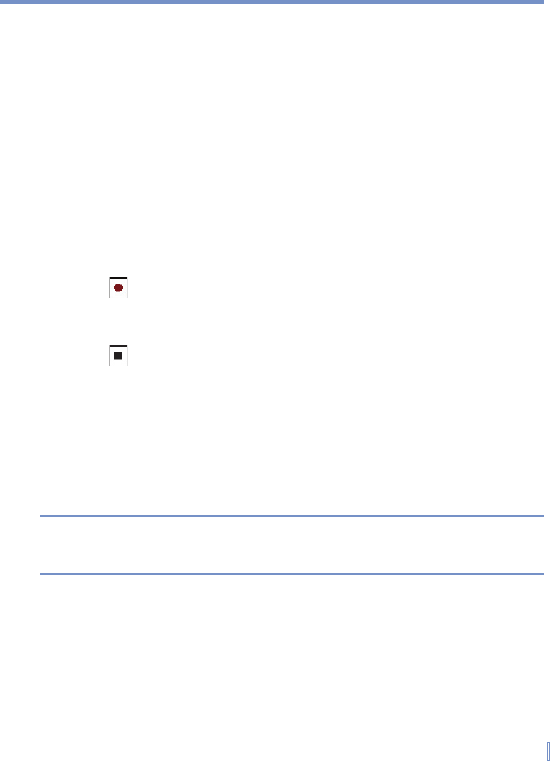
Entering and Searching Information | 27
2.3 Recording a Note
You can create a stand-alone recording (voice note) or you can add a
recording to a note. For more information about creating, changing, or
saving Notes, see “Notes” in Chapter 6.
To create a voice note
1.
Tap
Start
>
Programs
>
Notes
.
2.
Do one of the following:
•
To create a stand-alone recording, record from the note list.
•
To add a recording to a note, create or open a note.
3.
If you do not see the
Recording
toolbar, tap
Menu
>
View
Recording Toolbar
.
4.
Tap
to begin recording.
5.
Hold your device’s microphone near your mouth or other source
of sound.
6.
Tap
when fi nished recording.
7.
If you adding a recording to a note, tap
OK
to return to the note
list when fi nished.
8.
If you are recording in an open note, an icon will appear in the
note.
9.
I f you are creating a stand-alone recording, the recording will
appear in the note list.
Tip To quickly create a recording, press the RECORD button. When you
hear the beep, begin your recording. Release the button when you are
finished.
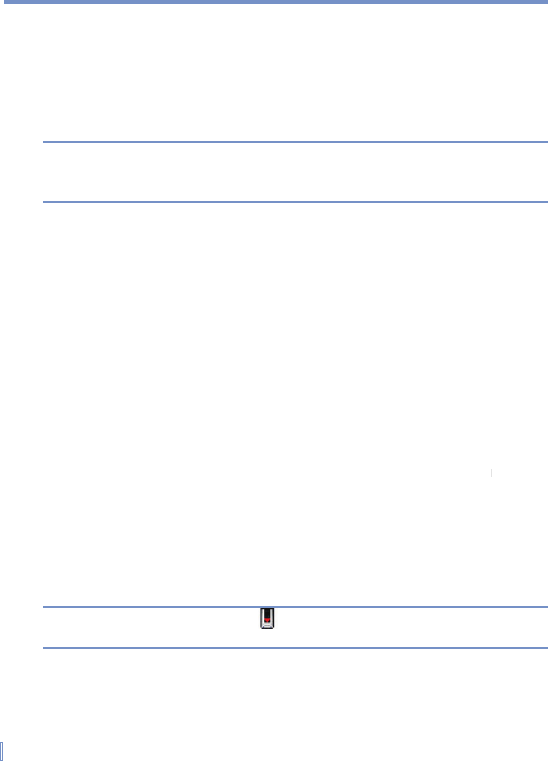
28 | Entering and Searching Information
To change recording formats
1.
Tap
Start
>
Settings
>
Personal
tab >
Input
.
2.
Tap the
Options
tab, and in the
Voice recording format
list
, tap
the format you want.
3.
Tap
OK
.
Note You can also change recording formats from within Notes. In the note
list, tap Menu >Options > Global Input Options link (at the bottom of
the page).
2.4 Searching Information
You can search for files and other items stored on your device in the
My Documents folder or on a storage card. You can search by file
name or by words located in the item. For example, you can search i
n
e-mail messages, notes, appointments, contacts, and tasks, as well as
in online Help.
To search for a fi le or an item
1.
Tap
Start
>
Programs
>
Search
.
2.
In
Search for
, enter the fi le name, word, or other information you
want to search for.
3.
If you have looked for this item before, tap the
Search for
arrow
Search for arrow Search for
and select the item from the list.
4.
In
Type
, select a data type to help narrow your search.
5.
Tap
Search
.
6.
The
My Documents
folder and subfolders are searched.
7.
In the
Results
list, tap the item you want to open.
Note The storage card symbol is displayed next to the names of files
saved on a storage card.

3.1 Using ActiveSync
3.2 Synchronizing Information
3.3 Synchronizing via Infrared
and Bluetooth
3.4 Synchronizing Music,
Video, and Pictures
Chapter 3
Synchronizing Your Pocket PC

30 | Synchronizing Your Pocket PC
3.1 Using ActiveSync
ActiveSync synchronizes information on your device with information
on your PC, such as Outlook content. ActiveSync can also synchronize
over a wireless network with Microsoft Exchange Server, if your
company or service provider is running Microsoft Exchange Server with
Exchange ActiveSync. When you synchronize, ActiveSync compares
the information on your device with the information on your PC and/or
Exchange Server and updates all locations with the most recent
information.
With ActiveSync, you can:
•
Synchronize information, such as Outlook E-mail, Contacts,
Calendar, or Tasks information on your device with your PC, as
well as pictures, video, and music.
•
Synchronize Outlook E-mail, Contacts, Calendar appointments,
and Tasks on your device directly with Exchange Server so that
you can stay up to date even when your PC is turned off.
•
Exchange fi les between your device and your PC without
synchronizing.
•
Select which types of information are synchronized and specify
how much information is synchronized. For example, you can
choose how many weeks of past Calendar appointments to
synchronize.
Before you can synchronize information with a PC, you must first install
ActiveSync on your PC and create a synchronization relationship
between your device and the PC. You can install ActiveSync from the
Getting Started disc that comes with your device. ActiveSync is already
installed on your device.
Once you have installed ActiveSync and set up a synchronization
relationship, ActiveSync on the PC recognizes your device when you
connect it, and automatically transfers the synchronization settings you
specified on your device.
You may be able to synchronize your device with Exchange Server
through your company or wireless service provider. If you plan to
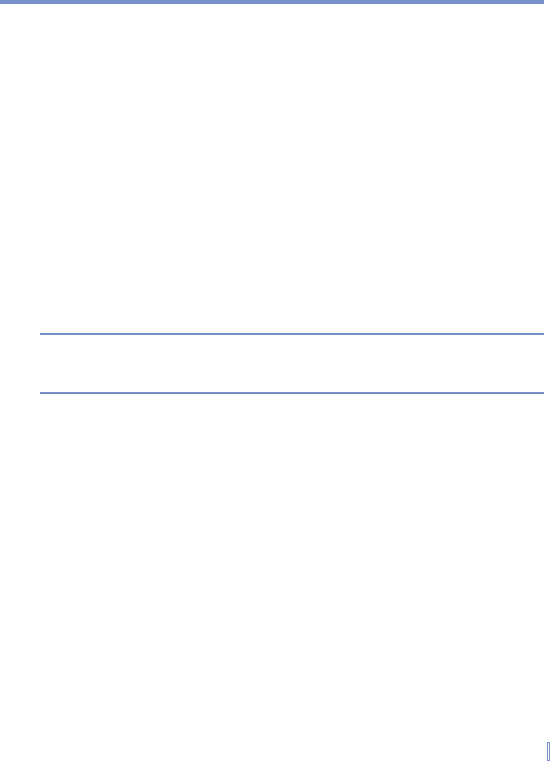
Synchronizing Your Pocket PC | 31
do so, obtain the name of the Exchange Server, your user name,
password, and domain name from your administrator before starting
the Sync Setup Wizard.
To install and set up ActiveSync
1.
Install ActiveSync on your PC, as described on the Getting
Started disc. After Setup completes, the Sync Setup Wizard
automatically starts when you connect your device to the PC.
2.
Follow the instructions on the screen to complete the wizard. In
the Sync Setup Wizard, do one or both of the following:
•
Create a synchronization relationship between your PC and
the device.
•
Configure an Exchange Server connection to synchronize
directly with Exchange Server.
3.
Choose information types to synchronize.
Note When you finish the wizard, ActiveSync synchronizes your device
automatically. Once synchronization completes, you can disconnect
your device from your PC.
3.2 Synchronizing Information
When you connect your device to the PC using a USB or serial cable,
an infrared connection, or a Bluetooth connection, ActiveSync will
immediately synchronize. While the device is connected, ActiveSync
synchronizes every time you make a change on either the PC or the
device.
Synchronizing Outlook information
If you have set up a synchronization relationship between your device
and the PC, synchronization keeps Outlook information up-to-date
on both computers. ActiveSync synchronizes a limited amount of
information by default to save storage space on your device. You can
change the amount of information synchronized for a given information
type in Settings for the information type.
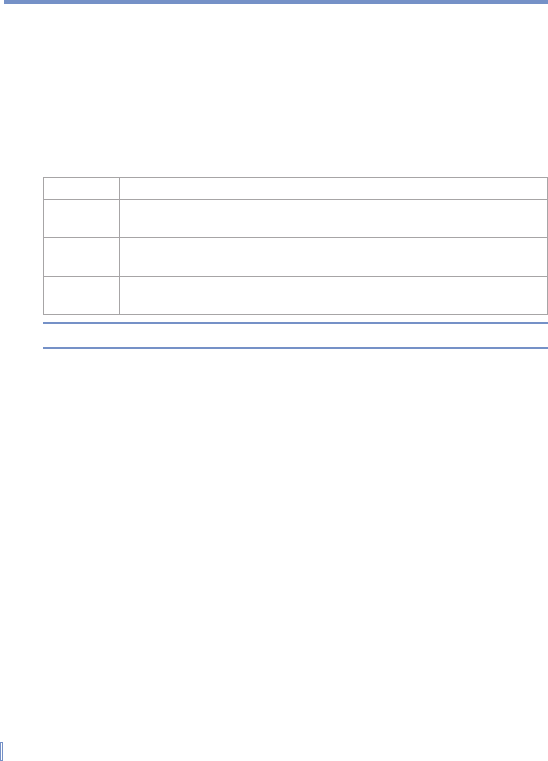
32 | Synchronizing Your Pocket PC
You can set up your device to synchronize with more than one PC or
with a combination of one or more PCs and Exchange Server. When
synchronizing with multiple computers, the items that you synchronize
will appear on all of the computers with which they are synchronized.
For example, if you have set up synchronization with two PCs (PC1
and PC2), which have different items, and you synchronize Contacts
and Calendar on the device with both computers, the result is as
follows:
Location
New state
PC1 All Outlook contacts and calendar appointments that were on PC2
are now also on PC1.
PC2 All Outlook contacts and calendar appointments that were on PC1
are now also on PC2.
Device All Outlook contacts and calendar appointments from both PC1
and PC2 are on the device.
Note Outlook e-mail can be synchronized with only one computer.
To start and stop synchronization
•
To synchronize Outlook information and other local information
on the PC, including media fi les, connect your device to the PC
using Bluetooth, infrared (IR) or a cable or cradle.
•
If you are synchronizing directly with Exchange Server, you can
use this connection to the PC to "pass though" to the network, or
you can synchronize without connecting to the PC over a cellular
or Wi-Fi network.
•
In ActiveSync, tap
Sync
.
•
To end synchronization before it completes, tap
Stop
.
To change which information is synchronized
1.
In ActiveSync on the device, tap
Menu
>
Options
.

Synchronizing Your Pocket PC | 33
2.
Do one or both of the following:
•
Select the check box for any items you want to synchronize.
If you cannot select a check box, you might have to clear the
check box for the same information type elsewhere in the list.
•
Clear the check box for any items you want to stop
synchronizing.
3.
To stop synchronizing with one PC completely, tap the PC and
tap
Delete
.
Notes Outlook e-mail can be synchronized with only one computer.
To change available synchronization settings, select the type of
information and tap Settings.
To synchronize directly with Exchange Server
You can set up synchronization with Exchange Server on your device,
if it is available to you through your company or wireless service
provider. However, you should first ask your administrator for the
following information and then carry on with the steps: Exchange
Server name, your user name, password, and domain name.
1.
In ActiveSync on the device, tap
Menu
>
Confi gure Server
. If
you have not yet set up synchronization with Exchange Server,
this will say
Add Server Source
.
2.
In
Server address
, enter the name of the server running
Exchange Server, and tap
Next
.
3.
Enter your user name, password, and domain, and tap
Next
.
•
To change the rules for resolving synchronization conflicts, tap
Advanced
.
4.
Select the check boxes for the types of information items that you
want to synchronize with Exchange Server.
5.
To change available synchronization settings, select the type of
information, and tap
Settings
.
6.
Tap
Finish
.

34 | Synchronizing Your Pocket PC
3.3 Synchronizing via Infrared and Bluetooth
You can connect your device to the PC to synchronize using the local
wireless technologies, such as infrared (IR) and Bluetooth. These
technologies have almost similar but slightly differing requirements.
To synchronize with a PC via infrared
1.
Follow the instructions in ActiveSync Help on the PC for setting
up your PC to receive infrared beams.
2.
Line up the infrared (IR) ports according to the instructions in the
manufacturer’s documentation for your device so that they are
unobstructed and within close range.
3.
On the device, tap
Start
>
Programs
>
ActiveSync
.
4.
Tap
Menu
>
Connect via IR
.
5.
Tap
Sync
.
To synchronize with a PC via Bluetooth
1.
Follow the instructions in ActiveSync Help on the PC for
confi guring Bluetooth on your PC to support ActiveSync.
2.
On the device, tap
Start
>
Programs
>
ActiveSync
.
3.
Tap
Menu
>
Connect via Bluetooth
. Make sure that Bluetooth is
turned on at the device and the PC, and that they are within close range.
4.
If this is the fi rst time you have connected to this PC via
Bluetooth, you must fi rst complete the Bluetooth wizard on the
device and set up a Bluetooth partnership between your device
and the PC.
For more information about enabling and configuring Bluetooth,
see Chapter 5 .
Note You can also use the Sync Setup Wizard to set up the device to
synchronize remotely with Exchange Server. This wizard is started
when you connect your mobile device to your PC after installing
ActiveSync on the PC.

Synchronizing Your Pocket PC | 35
3.4 Synchronizing Music, Video, and Pictures
If you want to carry your music or other digital media with you along
while you travel, ActiveSync works with Windows Media Player to
synchronize music, video, and pictures with your device.
Other than selecting the Media information type in ActiveSync to
be synchronized, all media synchronization settings must be set in
Windows Media Player. Before media can be synchronized, you must
do the following:
•
Install Windows Media Player Version 10 on the PC.
•
Connect your device to the PC with a USB cable. If the device
is currently connected using Bluetooth or infrared, you must end
that connection before media can be synchronized.
•
Insert a 32-MB or larger storage card into your device.
•
Set up a sync partnership between the storage card and
Windows Media Player.
Change Media synchronization settings
Once you select the Media information type in ActiveSync to be
synchronized, any of your favorite music, video, and picture files in
Windows Media Player playlists can be synchronized. All you have to
do is set up synchronization in Windows Media Player for those media
files.
To set up a sync relationship with a storage card
1.
Open Windows Media Player.
2.
Click the
Sync
tab.
3.
Select the storage card.
4.
Click
Set up Sync
.
For information about using Windows Media Player on the device, see
Chapter 7.

36 | Synchronizing Your Pocket PC

4.1 Personalizing Your Pocket PC
4.2 Adding and Removing Programs
4.3 Managing Memory
4.4 Backing Up Files
4.5 Protecting Your Device
4.6 Resetting Your Pocket PC
Chapter 4
Managing Your Pocket PC
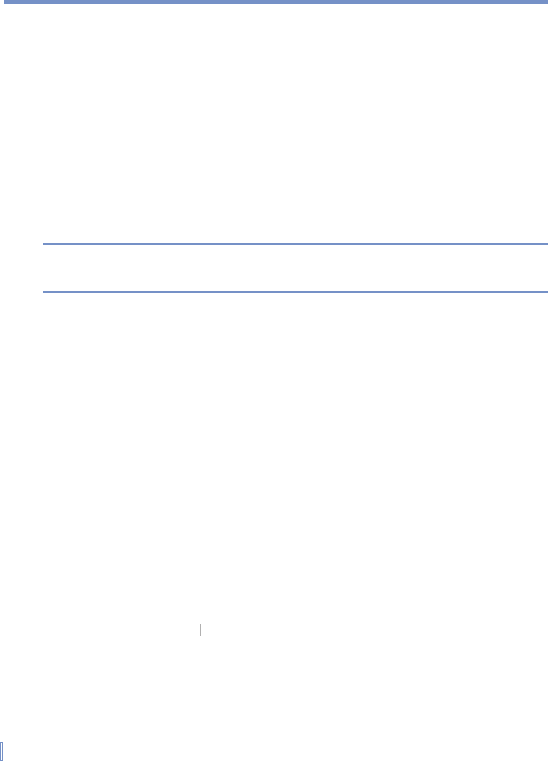
38 | Managing Your Pocket PC
4.1 Personalizing Your Pocket PC
Today screen settings
To customize the Today screen
1.
Tap
Start
>
Settings
>
Personal
tab >
Today
.
2.
On the
Appearance
tab, select the desired theme for the
background of the Today screen.
3.
On the
Items
tab, select the items you want to appear on the
Today screen.
Tip To change the order of items displayed on the Today screen, tap the
item, and tap Move Up or Move Down.
To add a custom background image
You can use one of your own pictures as the background image on the
Today screen. Be aware that pictures can affect the readability of text
on the Today screen.
1.
Tap
Start
>
Settings
>
Personal
tab
>
Today
.
2.
Select the
Use this picture
as the background
check box, and
tap
Browse
to view a list of your picture fi les.
3.
Tap the fi le name of the picture you want to use.
4.
Tap
OK
.
To set options for displaying appointments on the Today screen
If you have a large number of appointments, you may want to specify
the kind of appointments that are displayed on the Today screen.
1.
Tap
Start
>
Settings
>
Personal
tab >
Today
.
2.
Tap the
Items
tab.
3.
Select
Calendar
and tap
Calendar and tap Calendar
Options
.
4.
Do any of the following:
•
Select
Next appointment
to show only the next appointment
in your schedule, or
Upcoming
appointments
to show
multiple appointments.
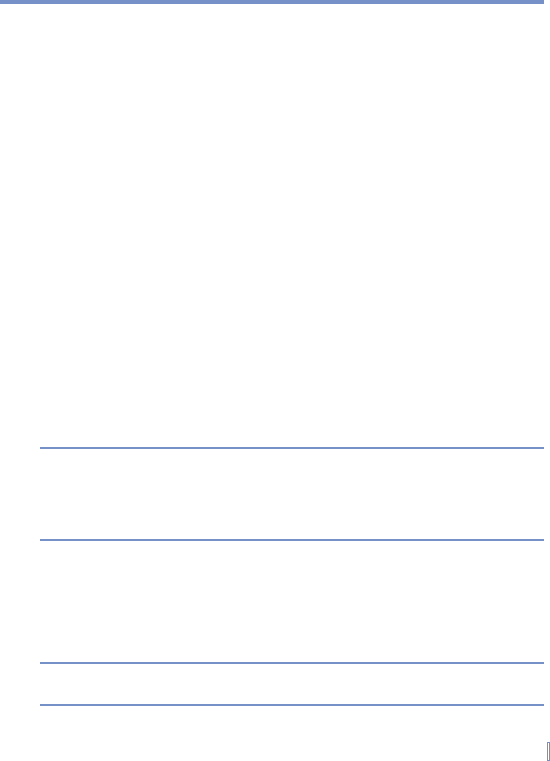
Managing Your Pocket PC | 39
•
Clear the Display all day events check box if you do not want
to display all-day events.
To set options for displaying tasks on the Today screen
If you have a large number of tasks, you may want to specify the kind
of tasks that are displayed on the Today screen.
1.
Tap
Start
>
Settings
>
Personal
tab >
Today
.
2.
Tap the
Items
tab.
3.
Select
Tasks
and tap
Options
.
4.
Do any of the following:
•
Under
Display number of
, select the type of tasks you want
to appear on the Today screen.
•
In the
Category
list, select whether to display only tasks
assigned to a specific category or to display all tasks.
Customize the Start menu
You can choose which items appear in the
Start
menu.
1.
Tap
Start
>
Settings
>
Personal
tab >
Menus
.
2.
Select the check boxes of the items you want to appear in the
Start
menu. You can select up to seven items.
Tip You can also create folders and shortcuts to appear on the Start menu.
In ActiveSync on your PC, click Explore. Double-click My Windows
Mobile-Based Device, click Windows, click Start Menu, and then
create the folders and shortcuts that you want. You will see the added
items after you synchronize.
Set Date / Time / Language / Regional Options
To set the time and date
1.
Tap
Start
>
Settings
>
System
tab >
Clock & Alarms
.
2.
Select the correct time zone and change the date or time.
Note During synchronization, the time on your device is updated with the time
on your PC.

40 | Managing Your Pocket PC
To set an alarm
1.
Tap
Start
>
Settings
>
System
tab >
Clock & Alarms
>
Alarms
tab.
2.
Tap
<
Description
>
and enter a name for the alarm.
3.
Tap the day of the week for the alarm. You can select multiple
days by tapping each desired day.
4.
Tap the time to open a clock and set the time for the alarm.
5.
Tap
to specify the type of alarm you want. You can choose a
fl ashing light, a single sound, a repeating sound, or vibration.
6.
If you choose to play a sound, tap the list next to the
Play sound
check box and tap the sound you want.
To set the time and date for a different location
If you visit or communicate with someone in a particular time zone
often, you can select it as your visiting time zone.
1.
Tap
Start
>
Settings
>
System
tab >
Clock & Alarms
.
2.
Tap
Visiting
.
3.
Select the correct time zone and change the time or date.
To change language and regional settings
The style in which numbers, currency, dates, and times are displayed
is specified in regional settings.
1.
Tap
Start
>
Settings
>
System
tab >
Regional Settings
.
2.
On the
Region
tab, select your region and language.
3.
The region you select determines which options will be available
on the other tabs.
4.
To customize settings further, tap the appropriate tabs and select
the desired options.

Managing Your Pocket PC | 41
Personal and system settings
To reassign programs or shortcuts to program buttons
Your device may come with programs already assigned to hardware
buttons. You can customize these buttons to open the programs you
use most, or to perform certain shortcuts such as changing the screen
orientation, opening the Today screen, or opening Input Panel.
1.
Tap
Start
>
Settings
>
Personal
tab >
Buttons
.
2.
A list of buttons and their current assignments is displayed on the
2. A list of buttons and their current assignments is displayed on the 2.
Program Buttons
tab.
3.
Tap the button you want to reassign. To help you identify the
buttons, there are numbers and icons representing the original
function of the button.
4.
In the
Assign a program
box, tap the program or shortcut you
want to assign.
5.
Tap
OK
.
To increase or decrease the size of text on the screen
1.
Tap
Start
>
Settings
>
System
tab >
Screen
>
Text Size
tab.
2.
Move the slider to increase or decrease the text size.
To enter owner information
Entering and displaying owner information are best practices; they
allow someone to return the device to you in case it is lost.
1.
Tap
Start
>
Settings
>
Personal
tab >
Owner Information
.
2.
On the
Identifi cation
tab, enter your personal information.
Tip If owner information is displayed on the Today screen, you can open
and edit the information directly from the Today screen. Just tap that
section of the screen.
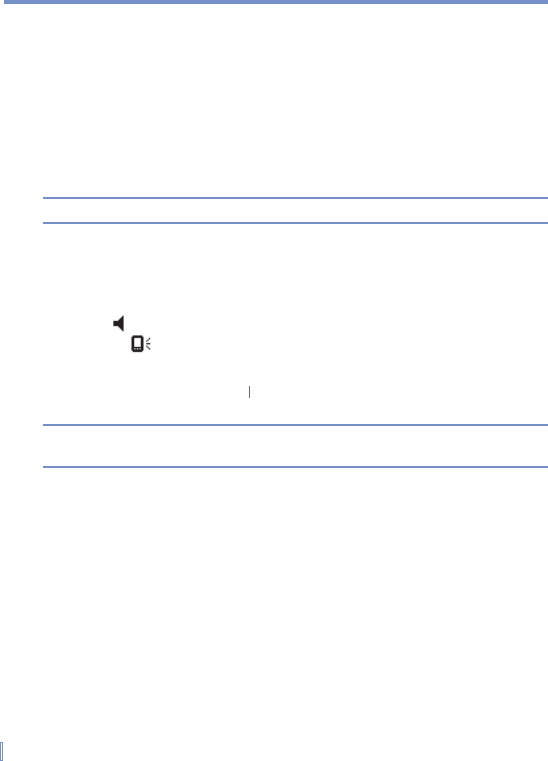
42 | Managing Your Pocket PC
To choose how to be notifi ed about events or actions
1.
Tap
Start
>
Settings
>
Personal
tab >
Sounds & Notifi cations
.
2.
On the
Sounds
tab, choose how you want to be notifi ed by
selecting the appropriate check boxes.
3.
On the
Notifi cations
tab, in
Event
, tap an event name and
choose how you want to be notifi ed by selecting the appropriate
check boxes. You can choose from several options, such as a
special sound, a message, or a fl ashing light.
Tip Turning off sounds and the flash light helps conserve battery power.
To adjust the volume for sounds
You can change the volume for sounds, such as the sound you hear
when you tap program names and menu options.
1.
Tap
.
2.
Under
, move the system volume slider to the desired volume
level.
3.
Tap
On
,
Vibrate
, or
Off
to quickly change both the system and
Off to quickly change both the system and Off
ringer volume settings.
Tip You can also press the volume control on your device to quickly change
both the ringer and system volume settings.

Managing Your Pocket PC | 43
To adjust the speed for scrolling
Pressing and holding NAVIGATION up or down (Up/Down control)
scrolls through the items in a list.
1.
Tap
Start
>
Settings
>
Personal
tab >
Buttons
>
Up
/
Down
Control
tab.
2.
Do one of the following:
•
Under
Delay before first repeat
, move the slider to shorten
or lengthen the time that elapses before scrolling begins.
•
To change the time it takes to scroll from one item to the next,
under
Repeat rate
, move the slider to adjust the speed.
To fi nd the operating system version number
•
Tap
Start
>
Settings
>
System
tab >
About
.
The version of the operating system on your device will be listed near
the top of the screen.
To get detailed device information
•
Tap
Start
>
Settings
>
System
tab>
About
.
The
Version
tab displays important device information, including the
type of processor and the amount of memory that is installed.
To change the device name
1.
Tap
Start
>
Settings
>
System
tab >
About
.
2.
Tap the
Device ID
tab.
3.
Enter a name.
The device name must begin with a letter, consist of letters from A to Z,
numbers from 0 to 9, and cannot contain spaces. Use the underscore
character to separate words.

44 | Managing Your Pocket PC
Why is the device name important?
The device name is used to identify the device in the following
situations:
•
Synchronizing with a PC
•
Connecting to a network
•
Restoring information from a backup
Note If you synchronize multiple devices with the same PC, each device must
have a unique name.
To make the battery last longer
The device battery power lasts based on the battery type and how you
use your device. Try the following to help preserve battery life:
•
Tap
Start
>
Settings
>
System
tab >
Power
. On the
Advanced
tab, you can specify when your device turns off to conserve
battery power. For optimum conservation, specify 3 minutes or
less.
•
Use the AC adapter to plug your device into external power
whenever possible, especially when using a CompactFlash card
or when using a modem or other peripherals.
•
Adjust the backlight settings.
To adjust the brightness of the backlight
1.
Tap
Start
>
Settings
>
System
tab >
Backlight
>
Brightness
tab.
2.
Move the sliders up to increase and down to decrease the
brightness.
To set the backlight to dim after a time delay
1.
Tap
Start
>
Settings
>
System
tab >
Backlight
.
2.
Tap the
Battery Power
tab or the
External Power
tab.
External Power tab.External Power
3.
Select the
Turn off backlight if device is not used for
check
Turn off backlight if device is not used for check Turn off backlight if device is not used for
box, and specify the time delay.

Managing Your Pocket PC | 45
4.2 Adding and Removing Programs
Before you purchase additional programs for your device, you should
note the name of your device, the version of Windows Mobile software
running on it, and the type of processor. This information will help
you select a program that is compatible with your device. For more
information, see "To get detailed device information" and "To find the
operating system version number" in this chapter.
Programs available for purchase usually include a Setup program
(commonly named "setup.exe") that you must first install on your PC.
You can then use ActiveSync to add programs to your device, or add a
program directly from the Internet.
To add programs
1.
Download the program to your PC (or insert the CD or disk
that contains the program into your PC). You may see a single
*.exe fi le, a *.zip fi le, a Setup.exe fi le, or several versions of fi les
for different device types and processors. Be sure to select a
program designed for your device and processor type.
2.
Read any installation instructions or documentation that comes
with the program. Many programs provide special installation
instructions.
3.
Connect your device and PC.
4.
Double-click the *.exe fi le.

46 | Managing Your Pocket PC
•
If the executable file is an installation wizard, follow the
instructions on the screen. Once the program has been
installed on your PC, the wizard will automatically transfer the
program to your device.
•
If an installation wizard does not start, you will see an
error message stating that the program is valid but that it
is designed for a different type of computer. You will need
to copy this program to your device. If you cannot find any
installation instructions for the program, use ActiveSync to
copy the program file to the Program Files folder on your
device.
To remove programs
You can only remove programs that you installed. Programs that come
with your device cannot be removed.
1.
Tap
Start
>
Settings
>
System
tab >
Remove Programs
.
2.
In the
Programs in storage memory
list, select the program you
want to remove, and tap
Remove
.
3.
Tap
Yes
. If another confi rmation message appears, tap
Yes
again.
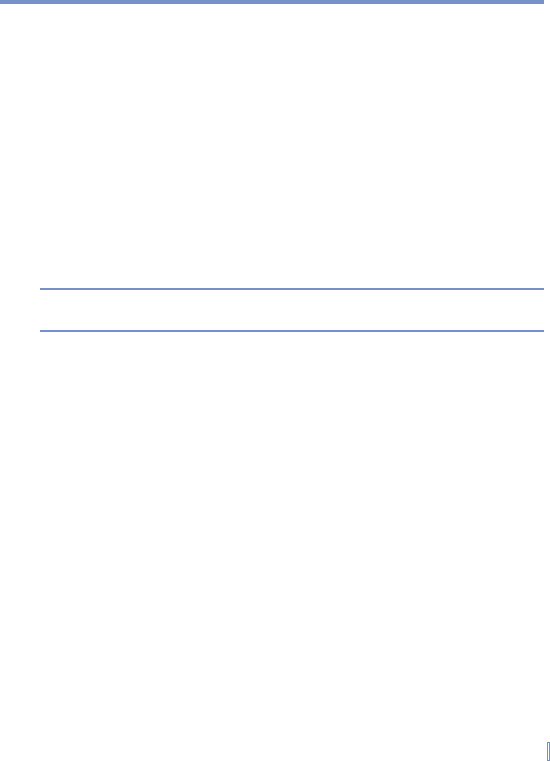
Managing Your Pocket PC | 47
4.3 Managing Memory
To see how much memory is available
•
Tap
Start
>
Settings
>
System
tab >
Memory
.
On the
Main
tab, the amount of memory allocated to file and data
storage versus program storage is displayed, as well as the amount of
memory in use versus the available memory.
To see available storage card memory
You can see how much memory is available on a storage card that is
inserted in your device.
1.
Tap
Start
>
Settings
>
System
tab >
Memory
.
2.
Tap the
Storage Card
tab.
Tip If you have more than one card inserted, tap the list box and then the
storage card whose information you want to see.
To free up program memory
Try the following to free memory on your device:
•
Close programs you are not currently using.
•
Move e-mail attachments to a storage card.
•
Move fi les to a storage card. Tap
Start
>
Programs
>
File
Explore
r
. Tap and hold the fi le, and tap
Cut
. Browse to the
storage card folder and tap
Edit
>
Paste
.
•
Delete unnecessary fi les. Tap
Star
t >
Programs
>
File
Explorer
.
Tap and hold the fi le, and tap
Delete
.
•
Delete large fi les. To fi nd your largest fi les, tap
Start
>
Programs
>
Search
. In the
Type
list, tap
Larger than 64 KB
, and tap
Search
.
•
In Internet Explorer Mobile, delete temporary Internet fi les and
clear history information. For more information, see "Internet
Explorer Mobile" in Chapter 5.
•
Remove programs you no longer use.
•
Reset your device.

48 | Managing Your Pocket PC
To close a program
In most cases, programs automatically close to free needed memory,
however, you can close programs manually, if you prefer.
1.
Tap
Start
>
Settings
>
System
tab >
Memory
>
Running
Programs
tab.
2.
I n the
Running Programs
list, tap the program you want to
close, and tap
Stop
.
Tip In most programs, you can also use the keyboard shortcut CTRL+Q to
close the program.
4.4 Backing Up Files
You can back up files to your PC using ActiveSync, or copy files to a
storage card you insert into your device. Your device has an expansion
slot compatible with a range of secure digital (SD) and multimedia
(MMC) storage cards.
Using ActiveSync, you can copy or move information from the PC to
the device and vice versa. Changes you make to the information on
one computer will not affect the information on the other computer. If
you want to automatically update information on both your device and
PC, synchronize the information instead. For more information about
copying and synchronizing files, see ActiveSync Help on your PC.
To copy fi les to a storage card
1.
Push the storage card into the storage card slot until it clicks into
place. The card is secure when it does not protrude from the
base.
2.
T ap
Start
>
Programs
>
File Explorer
and navigate to the
File Explorer and navigate to the File Explorer
appropriate folder.
3.
Tap and hold the fi le you want to copy, and tap
Copy
.
4.
Tap the folder list (labeled
My Documents
by default) and tap
Storage Card
.
5.
Tap
Menu
>
Edit
>
Paste
.

Managing Your Pocket PC | 49
To copy a fi le using ActiveSync
Copying a file results in separate versions of a file on your device and
PC. Because the files are not synchronized, changes made to one file
will not affect the other.
1.
Connect your device to your PC.
2.
In ActiveSync, click
Explore
, which opens the Mobile Device
folder for your device.
3.
In the Mobile Device folder, go to the fi le that you want to copy on
your device or PC.
4.
Do one of the following:
•
To copy the file to your device, right-click the file, and click
Copy
. Right-click the desired folder under Mobile Device, and
click Paste.
•
To copy the file to your PC, right-click the file and click
Copy
.
Right-click the desired folder on your PC, and click
Paste
.
To automatically save fi les on a storage card
In the Word Mobile, Excel Mobile, and Notes programs, you may find it
helpful to save all new documents, notes, and workbooks directly on a
storage card.
1.
From the program fi le list, tap
Menu
>
Options
.
2.
With a storage card inserted in the device, in the
Save to
box,
tap the appropriate storage card to automatically save new items
on the storage card.
3.
Tap
OK
.
Note In the file or note list, a storage card symbol is displayed next to the
names of files saved on a storage card.

50 | Managing Your Pocket PC
4.5 Protecting Your Device
You can prevent unauthorized access to any part of the device by
using password protection.
To protect your device with a password
You can help keep your data more secure by requiring a password
every time the device is turned on.
1.
Tap
Start
>
Settings
>
Personal
tab >
Password
.
2.
Select the
Prompt if device unused for
check box, and in the
Prompt if device unused for check box, and in the Prompt if device unused for
box to the right, select how long your device must be turned off
before a password is required. In the
Password type
box, select
the type of password you would like to use. Enter the password
and, if necessary, confi rm the password.
If your device is confi gured to connect to a network, use a strong
password to help protect network security.
3.
On the
Hint
tab, enter a phrase that will help you remember your
password, but doesn’t allow others to guess your password.
The hint will be displayed after the wrong password is entered
four times.
4.
Tap
OK
.
The next time the device is turned on, you will be prompted to
enter your password.
Notes Each time a wrong password is entered, the time the device takes to
respond will get longer and longer until the device appears to be not
responding.
If you forget your password, you must follow the instructions in your
owner’s manual to clear memory before you can access your device.
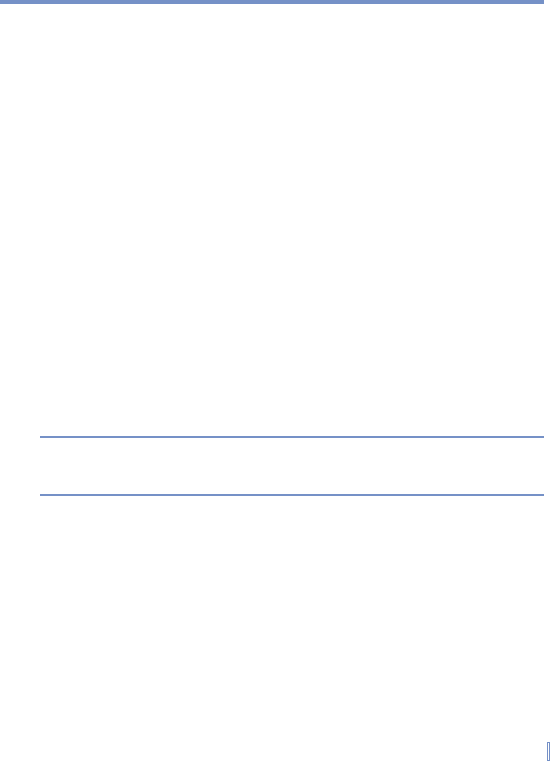
Managing Your Pocket PC | 51
To change your password
1.
Tap
Start
>
Settings
>
Personal
tab >
Password
. You will be
prompted to enter your current password.
2.
In the
Password
box, enter your new password.
3.
On the
Hint
tab, enter a phrase that will help you remember your
new password, but doesn’t allow others to guess your password.
The hint will be displayed after the wrong password is entered
four times.
4.
Tap
OK
.
To display owner information on the Today screen
Having your contact information displayed on the Today screen on
startup allows for easy identification of the device in case it is lost.
1.
Tap
Start
>
Settings
>
Personal
tab >
Owner Information
.
2.
On the
Options
tab, select the
Identifi cation information
check
box.
3.
On the
Options
tab, select the
Notes
check box
if you want
additional text displayed, such as: Reward if found.
4.
On the
Notes
tab, enter the additional text.
Tip To display owner information on the Today screen, tap Start > Settings
> Personal tab > Today. On the Items tab, select the Owner Info
check box.
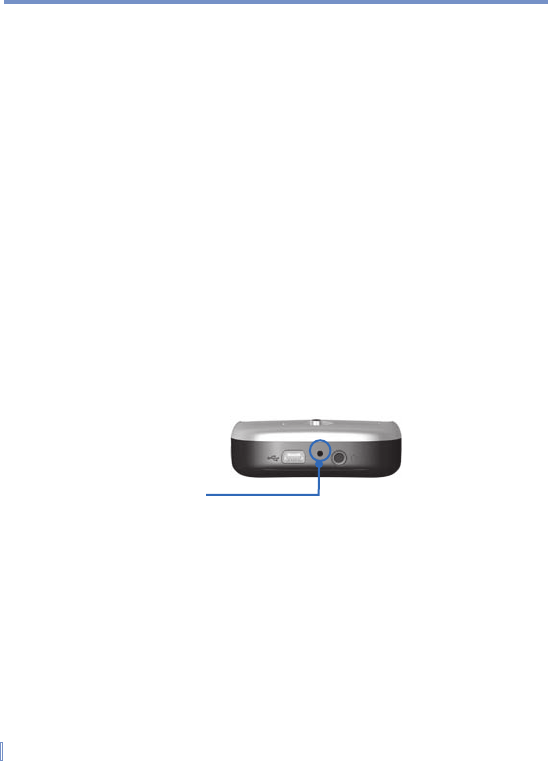
52 | Managing Your Pocket PC
4.6 Resetting Your Pocket PC
Occasionally you may need to reset your Pocket PC. A normal (or soft)
reset of your device clears all active program memory and shuts down
all active programs. This can be useful when the device is running
slower than normal, or a program is not performing properly. A soft
reset is also necessary after the installation of some programs. If a soft
reset is performed when programs are running, unsaved work will be
lost.
You can also perform a hard reset (also known as a full reset). A hard
reset should be performed only if a normal reset does not solve a
system problem. After a hard reset, the device is restored to its default
settings—the way it was when you first purchased it and turned it
on. Any programs you installed, data you entered, and settings you
customized on the device will be lost. Only Windows Mobile software
and other pre-installed programs will remain.
To perform a soft reset
•
Use the stylus to lightly press and hold the RESET button on the
bottom of your device.
The device restarts and displays the Today screen.
To perform a hard reset
•
Press and hold both SOFT KEYS shown enclosed by circles in
the picture below. Keep these keys pressed, and at the same
time, use the stylus to lightly press and hold the RESET button
on the left side of your device. Press either 0 to restore to factory
default or X to exit the hard reset process.
Soft Reset

5.1 Using Wireless Connection
5.2 Connecting to the Internet
5.3 Internet Explorer Mobile
5.4 Using Bluetooth
5.5 Using Terminal Services Client
Chapter 5
Getting Connected

54 | Getting Connected
5.1 Using Wireless Connection
To run Wireless LAN on your device, you need access to broadband
Internet, and the necessary access point or router that emits WLAN
signals. If you do not have access to broadband Internet, consult your
ISP before you try to run this utility. However, the availability and range
of your device’s WLAN signal depends on the number, infrastructure,
and other objects through which the signal passes.
Check for a Wireless LAN signal
Before you start a Wi-Fi connection, verify that your device has access
to a Wireless LAN channel signal. You can check the current wireless
connection status from the following two screens of your device.
•
Today screen. If your device detects a WLAN network
connection, the WLAN connection icon appears at the top of the
Today screen and a “W” icon appears at the bottom-right corner
of the screen.
•
WLAN Power Status screen. The current connection status and
power save mode for your Wireless connection.
Note WLAN (Wi-Fi) is the default wireless channel setting for your device.
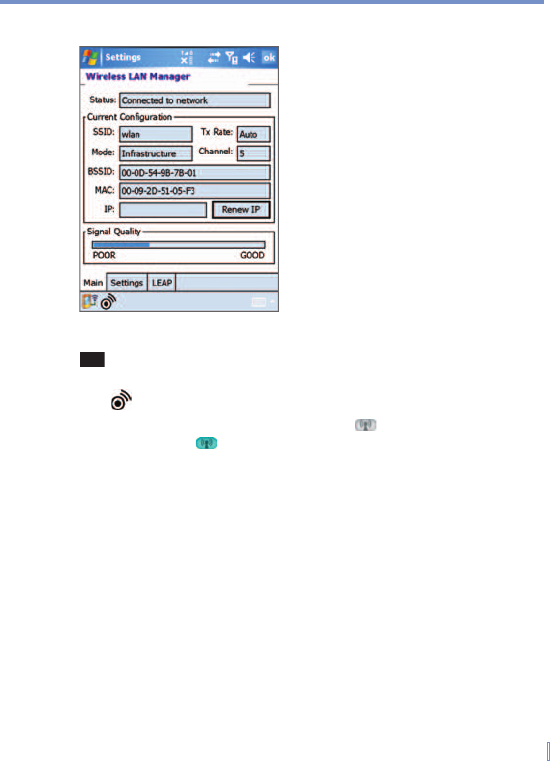
Getting Connected | 55
To connect to a Wi-Fi network
Wireless LAN
1.
Tap
Start
>
Settings
>
Connections
tab >
Wireless
WLAN
.
This
opens the Wireless LAN Main screen.
2.
Tap
to open Wireless Manager.
3.
Tap
On
corresponding to
WLAN icon (
)
.
The WLAN icon
is highlighted to indicate that Wi-Fi is turned
on.

56 | Getting Connected
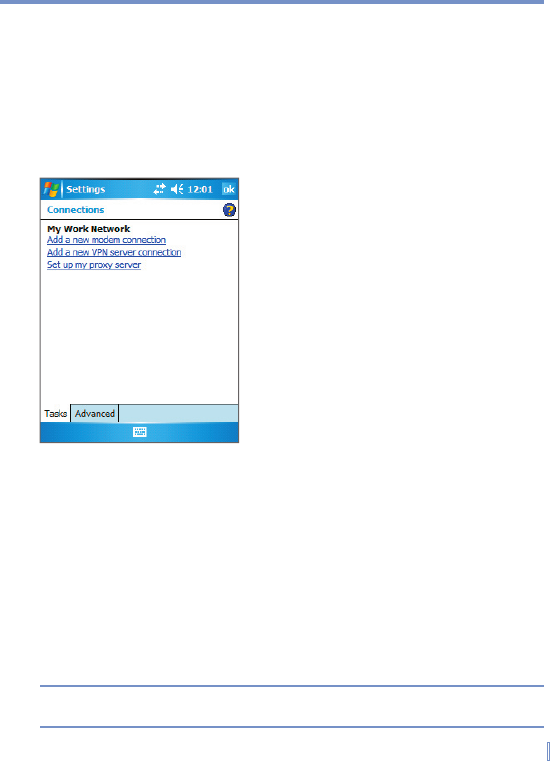
Getting Connected | 57
5.2 Connecting to the Internet
Your device is equipped with powerful networking functions that
enable you to connect to the Internet through a wireless network or
a Bluetooth modem. You can set up connections to the Internet or to
a corporate network to browse the Internet, and exchange e-mail or
instant messages.
To connect to a private network
Connection Setting
1.
Obtain the following information from your network administrator:
•
Server phone number
•
User name
•
Password
•
Domain (If provided by an ISP or a network administrator)
2.
Tap
Start
>
Settings
>
Connections
tab >
Connections
.
3.
I n
My Work Network
, follow the instructions for each type of
connection.
4.
Complete the connection wizard and tap
Finish
.
Note To start browsing the private network, tap Start > Programs > Internet
Explorer.

58 | Getting Connected
To reset or modify the network card settings on your device
1.
Tap
Start
>
Settings
>
Connections
tab >
Network Cards
>
N
etwork Adapters
tab.
2
.
In the
My network card connects
to
list
, select the appropriate
item:
•
If you want to connect to the Internet using your ISP, select
The Internet
.
•
If you want to connect to a private network, select
Work
.
3.
In
Tap an adapter to modify settings
, tap the appropriate
adapter.
The fields on the IP Address tab are populated automatically.
4.
Confi gure the TCP/IP settings, if required.
If your ISP or private network does not use dynamically-assigned
IP addresses, tap Use specific IP address and enter the
requested information. Contact your ISP or network administrator
to obtain the IP address, subnet mask, and/or default gateway (if
required).
5.
Confi gure the DNS and WINS settings, if required.
If your ISP or private network does not use dynamically-assigned
IP addresses, enter the requested information on the Name
Servers tab. Servers that require an assigned IP address may
also require a way to map computer names to IP addresses. DNS
and WINS are the resolution options supported on your device.

Getting Connected | 59
5.3 Internet Explorer Mobile
Internet Explorer Mobile is a full-featured Internet browser, optimized
for use on your mobile device.
To start Internet Explorer Mobile
•
Tap
Start
>
Internet Explorer
.
To choose a Home page
1.
In Internet Explorer Mobile, tap
Menu
>
Tools
>
Options
>
General
tab.
2.
Do one of the following:
•
To use the displayed page as your Home page, tap
Use
Current
.
•
To use the default Home page, tap
Use Default
.
Tip To go to your Home page, tap Menu > Home.
To transfer favorites from your PC
You can transfer the favorites you have stored on your PC to your
device by synchronizing the Internet Explorer favorites on your PC with
your device.
1.
I n ActiveSync on your PC, on the Tools menu, click
Options
, and
select
Favorites
.
2.
In Internet Explorer on your PC, save or move favorite links to the
Mobile Favorites subfolder in the Favorites list.
3.
Connect your mobile device to your PC. If synchronization does
not start automatically, click
Sync
.
To add a favorite
1.
In Internet Explorer Mobile, go to the page you want to add.
2.
Tap and hold the page, and tap
Add to Favorites
.
3.
Confi rm or change the name, and select a folder for storing the
favorite.

60 | Getting Connected
To delete a favorite or folder
1.
In Internet Explorer Mobile, tap
Menu
>
Favorites
>
Add
/
Delete
tab.
2.
Select the item you want to delete, and tap
Delete
.
To change how Web pages fi ll the screen
1.
In Internet Explorer Mobile, tap
Menu
>
View
.
2.
Tap one of the following:
•
One
Column
. Arranges the content into one column that is
as wide as the screen. This means that you will rarely have to
scroll horizontally.
•
Default
. Maintains a layout similar to what you see on a
desktop computer, but it makes items smaller and arranges
the content so that you can see most of it without having to
scroll horizontally.
•
Desktop
. Keeps the same layout and size as on a desktop
computer, which will require both horizontal and vertical
scrolling.
To change the size of text on Web pages
•
In Internet Explorer Mobile, tap
Menu
>
Zoom
, and tap the size
you want.
To show or hide pictures on Web pages
•
In Internet Explorer Mobile, tap
Menu
>
View
>
Show
Pictures
.
A check mark next to
Show Pictures
indicates that pictures will
be displayed on Web pages.
To clear the History list
1.
In Internet Explorer Mobile, tap
Menu
>
Tools
>
Options
>
Memory
tab.
2.
Tap
Clear History
.
To save a picture from a Web page
1.
In Internet Explorer Mobile, tap and hold the picture, and tap
Save Image
.
2.
Do one of the following:
•
To save the picture in
My Pictures
on your device, tap
Yes
.

Getting Connected | 61
•
To save the picture in another location, such as a storage
card, tap
Save As
.
To change cookies and security settings
Internet Explorer Mobile supports the protocols used by Secure
Sockets Layer (SSL). A connection that uses SSL helps you to send
personal information more safely.
Cookies are small files containing information about your identity and
preferences so that a page can tailor information to your needs. The
page sends the file, and it is stored on your mobile device.
1.
In Internet Explorer Mobile, tap
Menu
>
Tools
>
Options
>
Security
tab.
2.
Select the check boxes for the options you want, and click
OK
.
Tip To prevent Internet Explorer Mobile from accepting any cookies, clear
the Allow cookies check box.
To delete temporary Internet fi les
Some Web content is stored as you view it to speed up the display
of pages you frequently visit or have already seen. You may want to
delete these files to free storage space.
1.
In Internet Explorer Mobile, tap
Menu
>
Tools
>
Options
>
Memory
tab.
2.
Tap
Delete Files
.
All pages stored on your device, including offline favorites
content, will be deleted.

62 | Getting Connected
5.4 Using Comm Manager
Comm Manager (CManager) acts like a central switcher that lets you
easily enable or disable the following phone features:
•
Enable or disable Wi-Fi
•
Enable or disable Bluetooth
•
Switch on or off your device sound
•
Turn ActiveSync on or off
Simply click the corresponding buttons to enable or disable. When
a feature is enabled, its button becomes cyan in color. The button
appears gray when the corresponding feature is disabled.
To customize settings, click
Menu
then choose which phone feature you
want to configure.
See the corresponding sections or
chapters for details on
how to configure
settings.
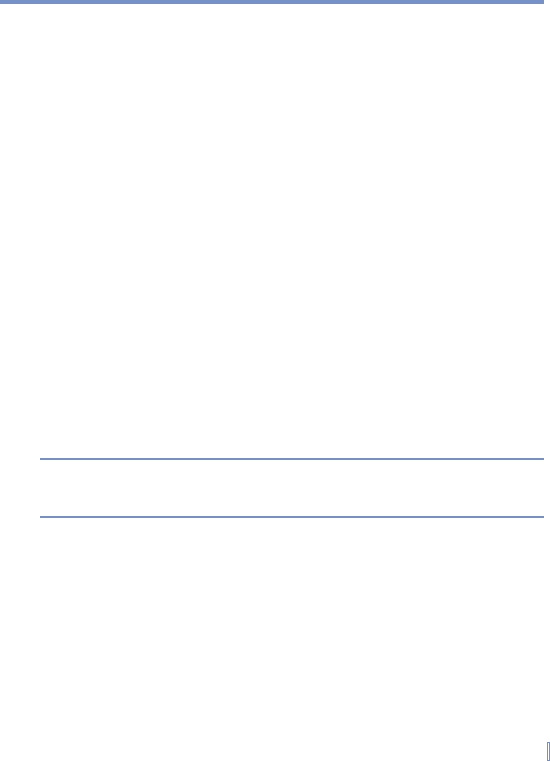
Getting Connected | 63
‘
5.5 Using Bluetooth
Bluetooth is a short-range wireless communications technology.
Devices with Bluetooth capabilities can exchange information over a
distance of about 10 meters without requiring a physical connection.
You can even beam information to a device in a different room, as long
as it is within range.
The software included with your device allows you to use Bluetooth in
the following ways:
•
Beam information, such as fi les, appointments, tasks, and contact
cards, between devices that have Bluetooth capabilities.
•
Create a dial-up modem connection between your device and a
Bluetooth-enabled phone, and then beam information using the
Bluetooth phone as a modem.
To turn on or off Bluetooth on your device
1.
On your device, tap
Start
>
Settings
>
Connections
tab >
Bluetooth
.
2.
Select the
Turn on Bluetooth
and
Make this device
discoverable to other devices
check boxes.
3.
Tap
OK
.
Note To add an extra layer of security while beaming information with other
devices, or to set up Bluetooth synchronization, tap Start > Settings >
System tab > Bluetooth Setting.
Bluetooth modes
Bluetooth on your device operates in three different modes:
•
On. Bluetooth is turned on and you can use Bluetooth features.
•
Off. Bluetooth is turned off. In this mode, you can neither send
nor receive information using Bluetooth. You might want to turn
the radio off at times in order to conserve battery power, or in
situations where radio use is prohibited, such as onboard an
aircraft and in hospitals.
•
Discoverable. Bluetooth is turned on, and all other Bluetooth-
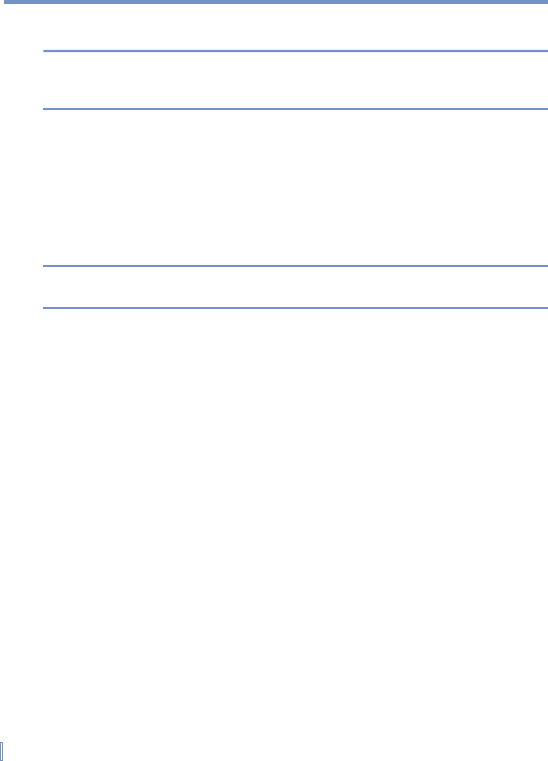
64 | Getting Connected
enabled devices within a range of 10 meters can detect your
device.
device.
Note By default, Bluetooth is turned off. If you turn it on, and then turn off your
device, Bluetooth also turns off. When you turn on your device again,
Bluetooth automatically turns on.
To make your device discoverable
1.
On your device, tap
Start
>
Settings
>
Connections
tab >
Bluetooth
.
2.
Select the
Turn on Bluetooth
and
Make this device
discoverable to other devices
check boxes.
3.
Tap
OK
.
Note Selecting the Make this device discoverable to other devices check
box also turns on Bluetooth.
Bluetooth partnerships
A Bluetooth partnership is a relationship that you create between your
device and another Bluetooth-enabled device in order to exchange
information in a secure manner. Creating a partnership between two
devices involves entering the same personal identification number
(PIN) on both devices. Creating a partnership between two devices is
a one-time process. Once a partnership is created, the devices can
recognize the partnership and exchange information without entering a
PIN again. Make sure the two devices are within a range of 10 meters
from one another, and Bluetooth is turned on and in discoverable
mode.
To create a Bluetooth partnership
1.
On your device, tap
Start
>
Settings
>
Connections
tab >
Bluetooth
.
2.
On the Devices tab, tap
New Partnership
.
Your device searches for other Bluetooth devices and displays
them in the box.
3.
Tap the desired device name in the box.
4.
Tap
Next
.

Getting Connected | 65
5.
Enter a passkey to establish a secure connection.
The passkey must be between 1 and 16 characters.
6.
Tap
Next
.
7.
Enter the same passkey that is entered on the other device.
You can, however, edit and enter a new name for the other
device.
8.
Tap
Finish
.
To accept a Bluetooth partnership
1.
Ensure that Bluetooth is turned on and in discoverable mode.
2.
Tap
OK
when prompted to establish a partnership with the other
device.
3.
Enter a passkey (the same passkey that is entered on the device
requesting the partnership) to establish a secure connection.
The
passkey must be between 1 and 16 characters.
4.
Tap
Next
.
5.
Tap
Finish
.
You can now exchange information with the other device.
To rename a Bluetooth partnership
1.
Tap
Start
>
Settings
>
Connections
tab >
Bluetooth
.
2.
Tap and hold the partnership on the
Devices
tab.
3.
On the shortcut menu, tap
Edit
.
4.
Enter a new name for the partnership.
5.
Tap
Save
.
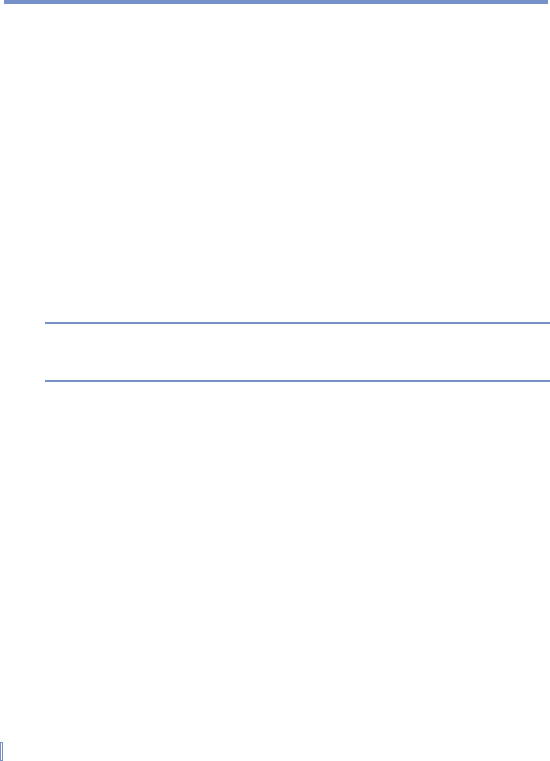
66 | Getting Connected
To delete a Bluetooth partnership
1.
Tap
Start
>
Settings
>
Connections
tab >
Bluetooth
.
2.
Tap and hold the partnership on the
Devices
tab.
3.
Tap
Delete
from the shortcut menu.
Beam information using Bluetooth
To beam information from your device
1.
On the device, tap and hold an item to beam.
The item can be an appointment in your calendar, a task, a
contact card, or a file.
2.
Tap
Beam
[
type of item
]
.
3.
Tap the device name to which you want to send the beam.
The item is beamed to the device you selected.
Note If the device you want to beam to does not appear in the box, make sure
that it is turned on, discoverable, and within close range (10 meters) of
your device.
Use a Bluetooth device as a modem
You can use a phone that has Bluetooth capabilities as a modem for
your device.
To do so, create a Bluetooth modem connection on your device and
then send information to another device by using Bluetooth. The device
relays the information over the network and then sends back to your
device any information that you had requested over the connection.
Once you create a modem connection to the Bluetooth phone, you can
reuse it whenever you want to use the phone as a modem. Make sure
that your device and the destination device are turned on, Bluetooth is
turned on, and that the devices are within close range.

Getting Connected | 67
To confi gure and use a Bluetooth device as a modem
1.
On your device, tap
Start
>
Settings
>
Connections
tab >
Connections
.
2.
Tap
Add a new modem connection
.
3.
Enter a name for the connection.
4.
In the
Select a modem
list, tap
Bluetooth
.
5.
Tap
Next
.
6.
If the device appears in the
My Connections
list, skip to step 11.
7.
If the device does not appear in the
My Connections
list, tap
New
, and follow the remaining steps.
8.
Select the device name from the list and tap
Next
.
9.
Enter a passkey and tap
Next
.
10.
Enter the same passkey on the device and tap
Finish
.
11.
In the My Connections list, tap the device and tap
Next
.
12.
Enter the phone number to dial for this connection and tap
Next
.
13.
Enter the required logon information for this connection and tap
Finish
.
You can start using this service for the program that uses the Bluetooth
connection, such as Inbox on your device, to send and receive e-mail,
or Internet Explorer to browse the Web.

68 | Getting Connected
5.6 Using Terminal Services Client
The Terminal Services Client allows you to log on to a PC running
Terminal Services or Remote Desktop, and use all the resources
available on that PC. For example, instead of running Word Mobile on
your device, you can run the PC version of Word and access the .doc
files available on that PC.
Connect to a Terminal Server
1.
On your device, tap
Start
>
Programs
>
Terminal Services
Client
.
2.
Enter the server name.
3.
You can also select a server name in
Recent servers
if you have
recently connected to a server.
4.
Select the
Limit size of server desktop to fi t on this scree
n
check box if you want to use programs that have been specifi cally
sized for use with your device.
5. Tap
Connect
.
Navigate within Terminal Services Client
When connected to a remote server, you may notice that your device
screen is displaying more than one horizontal and vertical scroll bar.
Use these scroll bars to either scroll the contents on the PC, or to scroll
the PC display through the Terminal Services Client window.
To make sure you are scrolling the PC display through Terminal
Services Client, use the five directional buttons at the bottom of the
Terminal Services Client window. To better fit information on your
device screen, select the
Limit size of server desktop to fit on this
screen
check box. For best results, the programs on your PC should
be maximized.

Getting Connected | 69
Disconnect without ending a session
1.
From the Terminal Services Client screen on your device, tap
Start
>
Shutdown
.
2.
Tap
Disconnect
.
Notes Do not use the Start menu on your device.
If a network administrator has configured Terminal Services Client on
your device to reconnect to disconnected sessions, and you previously
disconnected from a Terminal Server without ending the session, the
Terminal Services Client reconnects to that session.
Disconnect after ending a session
1.
From the Terminal Services Client screen on your device, tap
Start
>
Shutdown
.
2.
Tap
Log Off
.

6.1 E-mail and Text Messages
6.2 Pocket MSN Messenger
6.3 Calendar
6.4 Contacts
6.5 Tasks
6.6 Notes
Chapter 6
Exchanging Messages
and Using Outlook

70 | Exchanging Messages and Using Outlook
6.1 E-mail and Text Messages
Messaging is where all of your e-mail accounts and your text message
account are located. You can send and receive Outlook e-mail, Internet
e-mail through an Internet service provider (ISP), and text messages.
You can also access e-mail from work using a VPN connection. For
more information about e-mail and text messages, see Help on the
device.
To set up an e-mail account
You need to set up an e-mail account that you have with an Internet
service provider (ISP) or an account that you access using a VPN
server connection (typically a work account) before you can send and
receive mail.
1.
Tap
Start
>
Messaging
.
2.
Tap
Menu
>
Tools
>
New Account
.
3.
Enter your e-mail address, and tap
Next
.
Auto configuration
attempts to download necessary e-mail
server settings so that you do not need to enter them manually.
4.
Once
Auto confi guration
has fi nished, tap
Next
.
5.
Enter your name (the name you want displayed when you send
e-mail), user name, and password; tap
Next
.
Select the
Save Password
check box if you want to save your
password so that you do not need to enter it again.
If
Auto configuration
was successful, the
Your name
and
User
name
fields automatically get populated. Tap
Next
, and then
Finish
to
complete setting up your account, or tap
Options
to access additional
settings. For example:
•
Change the time intervals for downloading new messages.
•
Limit the amount of messages that are downloaded and
authentication method for outgoing mails.
•
Download attachments or parts of messages.
If
Auto configuration
is unsuccessful or you have an account you
access using a VPN server connection, contact your ISP or network
administrator for the following information and enter it manually:
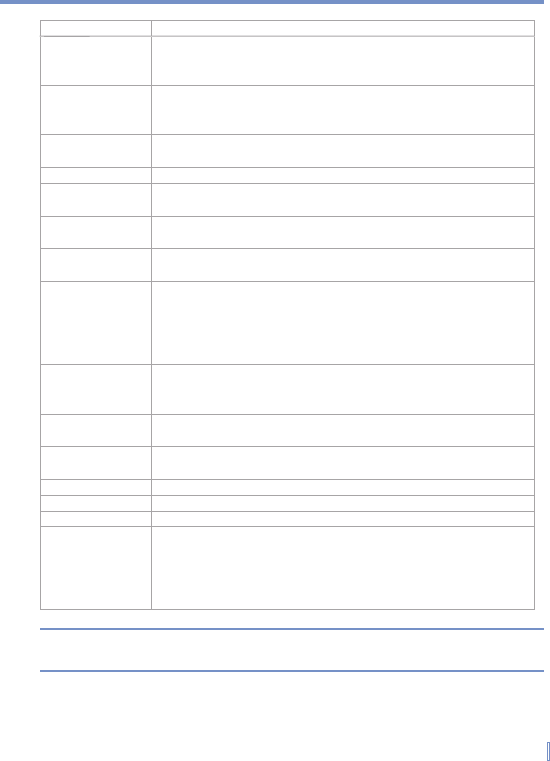
Exchanging Messages and Using Outlook | 71
Setting
Setting
Description
Description
User name Enter the user name assigned to you by your ISP or network
administrator. This is often the first part of your e-mail
address, which appears before the at sign (@).
Password Choose a strong password. You have the option to save
your password so you do not need to enter it each time you
connect to your e-mail server.
Domain Not required for an account with an ISP. May be required for
a work account.
Account type Select POP3 or IMAP4.
Account name Enter a unique name for the account, such as Work or
Home. This name cannot be changed later.
Incoming mail
server
Enter the name of your e-mail server (POP3 or IMAP4).
Outgoing mail
server
Enter the name of your outgoing e-mail server (SMTP).
Require SSL
connection
Select this to ensure that you always send e-mail from this
account using an SSL connection. This enables you to send
personal information more securely. Note that if you select
this and your ISP does not support an SSL connection, you
will not be able to send e-mail.
Outgoing
mail requires
authentication
Select this if your outgoing e-mail server (SMTP) requires
authentication. Your user name and password from above
will be used.
Use separate
settings
Select this if your outgoing e-mail server requires a different
user name and password than the ones you entered before.
Outgoing
server settings:
User name Enter your user name for the outgoing e-mail server.
Password Enter your password for the outgoing e-mail server.
Domain Enter the domain of the outgoing e-mail server.
Require SSL for
outgoing mail
Select this to ensure you always send e-mail from this
account using an SSL connection. This enables you to send
personal information more securely. Note that if you select
this and your ISP does not support an SSL connection, you
will not be able to send e-mail.
Tip You can set up several e-mail accounts in addition to your Outlook E-
mail account.

72 | Exchanging Messages and Using Outlook
To compose and send a message
1.
In the message list, tap
Menu
>
Switch Accounts
and select an
account.
2.
Tap
New
.
3.
Enter the e-mail address or text message address of one or
more recipients, separating them with a semicolon. To access
addresses and phone numbers from Contacts, tap
To
.
4.
Enter your message. To quickly add common messages, tap
Menu
>
My Text
and tap a desired message.
5.
To check the spelling, tap
Menu
>
Spell Check
.
6.
Tap
Send
.
Tips To enter symbols, tap Shift using the on-screen keyboard.
To set the priority, tap Menu > Message Options.
If you are working offline, e-mail messages are moved to the Outbox
folder and will be sent the next time you connect.
If you are sending a text message and want to know if it was received,
before sending the message, tap Menu > Tools > Options. Tap Text
Messages and select the Request delivery notification check box.
To reply to or forward a message
1.
Open the message and tap
Reply
, or
Menu
>
Reply All
, or
Menu
>
Forward
.
2.
Enter your response. To quickly add common messages, tap
Menu
>
My Text
and tap a desired message.
3.
To check the spelling, tap
Menu
>
Spell Check
.
4.
Tap
Send
.
Tips To see more header information, scroll up.
To always include the original message, from the list view, tap Menu
> Tools > Options > Message tab, and select the When replying to
e-mail, include body check box.

Exchanging Messages and Using Outlook | 73
In the Outlook E-mail account, you will send less data if you do not edit
the original message. This may reduce data transfer costs based on
your rate plan.
To add an attachment to a message
1.
In an open message, tap
Menu
>
Insert
and tap the item you
want to attach:
Picture
,
Voice Note
, or
File
.
2.
Select the fi le you want to attach, or record a voice note.
To receive attachments
An attachment sent with an e-mail message or downloaded from
the server appears below the subject of the message. Tapping the
attachment opens the attachment if it has been fully downloaded, or
marks it for download the next time you send and receive e-mail. You
can also download attachments automatically with your messages if
you have an Outlook E-mail or IMAP4 E-mail account.
If you have an Outlook E-mail account, do the following:
1.
Tap
Start
>
ActiveSync
.
2.
Tap
Menu
>
Options
.
3.
Tap
E-mail
>
Settings
, and then select
Include File
Attachments
.
If you have an IMAP4 E-mail account with an Internet service provider
(ISP) or an account that you access using a VPN server connection
(typically a work account), do the following:
1.
Tap
Start
>
Messaging
.
2.
Tap
Menu
>
Tools
>
Options
.
3.
Tap the name of the IMAP4 account.
4.
Tap
Next
until you reach
Server information
, and tap
Options
.
5.
Tap
Next
twice, and select
Get full copy of messages
and
When getting full copy, get attachments
.
Tip To store attachments on a storage card rather than on the device,
tap Menu > Tools > Options > Storage tab, and select the Store
attachments on a storage card check box.

74 | Exchanging Messages and Using Outlook
Downloading messages
The manner in which you download messages depends the type of
account you have:
•
To send and receive e-mail for an Outlook E-mail account, begin
synchronization through ActiveSync. For more information, see
"Synchronizing Outlook information" in Chapter 3.
•
To send and receive e-mail messages for an e-mail account
that you have with an Internet Service Provider (ISP) or that you
access using a VPN server connection (typically a work account),
download messages through a remote e-mail server. For more
information, see "To download messages from the server" later in
this chapter.
To download messages from the server
To send and receive e-mail messages for an e-mail account that you
have with an Internet Service Provider (ISP) or that you access using
a VPN server connection (typically a work account), you first need to
connect to the Internet or your corporate network, depending on the
account.
1.
Tap
Menu
>
Switch Accounts
and tap the account you want to
use.
2.
Tap
Menu
>
Send/Receive
. The messages on your device and
e-mail server are synchronized: new messages are downloaded
to the device Inbox folder, messages in the device Outbox folder
are sent, and messages that have been deleted from the server
are removed from the device Inbox folder.
Tips If you want to read the entire message, tap Menu > Download
Message while in the message window. If you are in the message list,
tap and hold the message, and tap Menu > Download Message. The
message will download the next time you send and receive e-mail. This
will also download message attachments if you selected those options
when you set up the e-mail account.

Exchanging Messages and Using Outlook | 75
Managing folders
Each Messaging account has its own folder hierarchy with five default
Messaging folders: Inbox, Outbox, Deleted Items, Drafts, and Sent
Items. The messages you receive and send through the account are
stored in these folders. You can also create additional folders within
each hierarchy. The Deleted Items folder contains messages that
have been deleted on the device. The behavior of the Deleted Items
and Sent Items folders depends on the Messaging options you have
chosen.
If you use an Outlook E-mail account, e-mail messages in the Inbox
folder in Outlook will be synchronized automatically with your device.
You can select to synchronize additional folders by designating them
for synchronization. The folders you create and the messages you
move will then be mirrored on the e-mail server. For example, if you
move two messages from the Inbox folder to a folder named Family,
and you have designated Family for synchronization, the server
creates a copy of the Family folder and copies the messages to that
folder. You can then read the messages while you are away from your
PC.
If you use a text message account, messages are stored in the Inbox
folder.
If you use a POP3 account and you move e-mail messages to a folder
you created, the link is broken between the messages on the device
and their copies on the e-mail server. The next time you connect, the
e-mail server will detect that the messages are missing from the Inbox
folder on the device and will delete them from the e-mail server. This
prevents having duplicate copies of a message, but it also means that
you will no longer have access to messages that you move to folders
created from anywhere except the device.
If you use an IMAP4 account, the folders you create and the e-mail
messages you move are mirrored on the e-mail server. Therefore,
messages are available to you anytime you connect to your e-mail
server, whether it is from your device or PC. This synchronization of
folders occurs whenever you connect to your e-mail server, create new

76 | Exchanging Messages and Using Outlook
folders, or rename/delete folders when connected. You can also set
different download options for each folder.
6.2 Pocket MSN
MSN Messenger delivers the features of MSN Messenger to your
mobile device. With Pocket MSN Messenger you can do the following:
•
Send and receive instant messages.
•
See which contacts are online or offl ine.
•
Subscribe to status updates for selected contacts so you know
when they come online.
•
Block contacts from seeing your status or sending you messages.
Before you can use MSN Messenger, your device must be connected
to the Internet. For information about setting up an Internet connection,
see “Connecting to the Internet” in Chapter 5, “Getting Connected.”
Note You must have either a Microsoft .NET Passport or Hotmail account to
use MSN Messenger. If you have a Hotmail.com or MSN.com e-mail
address, you already have a Passport. To get a Passport account, go
to http://www.passport.com. To get a Hotmail account, go to http://www.
hotmail.com.
To start MSN Messenger
1.
Tap
Start
>
Programs
>
Pocket MS
N
.
2.
Tap
Messenger
.
To sign in or out
•
To sign in, tap anywhere on the MSN Messenger screen. Enter
the e-mail address and password for your Passport or Hotmail
account, and tap
Sign In
.
Signing in may take several minutes, depending on your
connection speed.
•
To sign out, tap
Menu
>
Sign Out
.
Your status changes to Offl ine.

Exchanging Messages and Using Outlook | 77
To add or delete contacts
•
To add a contact, tap
Menu
>
Add a Contact
, and follow the
instructions on the screen.
•
To delete a contact, tap and hold the contact's name, and tap
Delete Contact
.
To send an instant message
1.
Tap the contact to whom you want to send a message.
2.
Enter your message in the text entry area at the bottom of the
screen, and tap Send.
Tip To quickly add common phrases, tap Menu > My Text and select a
phrase in the list.
To block or unblock contacts
•
To block a contact from seeing your status and sending you
messages, tap and hold the contact, and tap Block.
•
To unblock a contact, tap and hold the name of the blocked
contact, and tap Unblock.
To check your own Messenger status
•
Tap and hold your own name at the top of the page.
Your current status is indicated in the displayed list by a bullet point.
To change your display name
1.
Tap
Menu
>
Options
>
Messenger
tab.
Messenger tab. Messenger
2.
Enter the name you want to display to others in MSN Messenger.
To get more help about MSN Messenger
•
From within MSN Messenger, tap
Start
>
Help
.
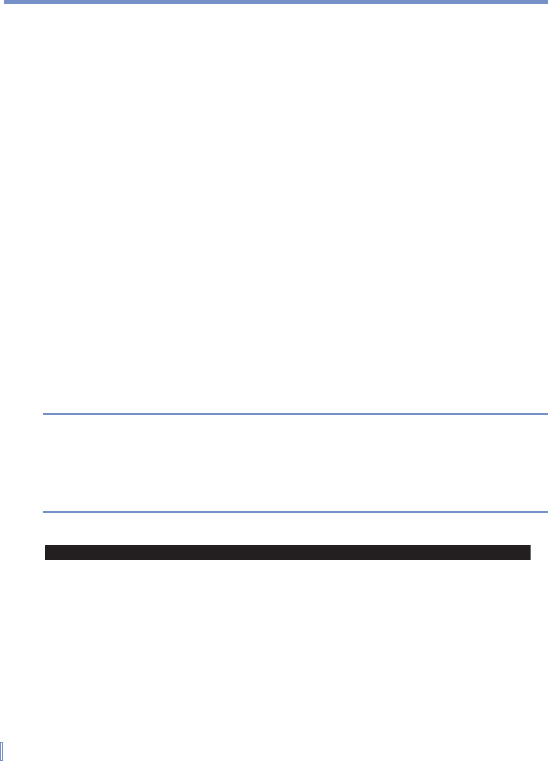
78 | Exchanging Messages and Using Outlook
6.3 Calendar
Use Calendar to schedule appointments, including meetings and
other events. Your appointments for the day can be displayed on the
Today screen. If you use Outlook on your PC, you can synchronize
appointments between your device and PC. You can also set Calendar
to remind you of appointments with a sound or flashing light, for
example.
You can look at your appointments in several different views (Day,
Week, Month, Year, and Agenda). To see detailed appointment
information in any view, tap the appointment.
To schedule an appointment
1.
Tap
Start
>
Calendar
.
2.
Tap
Menu
>
New Appointment
.
3.
Enter a name for the appointment, and enter information such as
start and end times.
4.
To schedule an all-day event, in the
All Day
box, tap
Yes
.
5.
When fi nished, tap
OK
to return to the calendar.
Notes All-day events do not occupy blocks of time in Calendar; instead, they
appear in banners at the top of the calendar.
To cancel an appointment, tap the appointment and tap Menu > Delete.
Tip To have the time entered automatically in Day view, tap the time slot for
the new appointment, and tap Menu > New Appointment.
To send a meeting request
Use Calendar to schedule meetings via e-mail with contacts who use
Outlook or Outlook Mobile.
1.
Tap
Start
>
Calendar
.
2.
Schedule a new appointment, or open an existing one and tap
Edit
.
3.
Tap
Attendees
.
4.
Tap the name of the contact you want to invite.
5.
To invite each additional attendee, tap
Add
and tap the name.

Exchanging Messages and Using Outlook | 79
6.
Tap
OK
.
7.
The meeting request will be sent to the attendees the next time
you synchronize your device with your PC.
Note When attendees accept your meeting request, the meeting is
automatically added to their schedules. When their response is sent
back to you, your calendar is updated as well.
To set a default reminder for all new appointments
You can have a reminder automatically turned on for all new
appointments you schedule.
1.
Tap
Start
>
Calendar
.
2.
Tap
Menu
>
Options
>
Appointments
tab.
3.
Select the
Set reminders for new items
check box.
4.
Set the time when you want the reminder to alert you.
5.
Tap
OK
to return to the calendar.
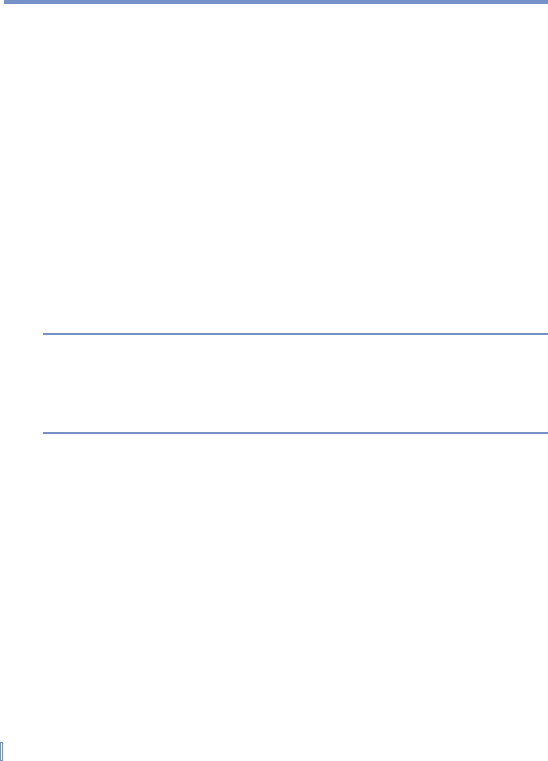
80 | Exchanging Messages and Using Outlook
6.4 Contacts
Contacts is your address book and information storage for the people
and businesses you communicate with. Store phone numbers, e-mail
addresses, home addresses, and any other information that relates to
a contact, such as a birthday or an anniversary date. You can also add
a picture to a contact.
From the contact list, you can quickly communicate with people. Tap
a contact in the list for a summary of contact information. If you use
Outlook on your PC, you can synchronize contacts between your
device and PC.
To create a contact
1.
Tap
Start
>
Contacts
.
2.
Tap
New
and enter the contact information.
3.
When fi nished, tap
OK
.
Tips If someone who is not in your list of contacts calls you or sends you
a message, you can create a contact from Call History, or from the
message by tapping Menu > Save to Contacts.
In the list of contact information, you’ll see where you can add a picture
or assign a ring tone to a contact.
To change contact information
1.
Tap
Start
>
Contacts
.
2.
Tap the contact.
3.
Tap
Menu
>
Edit
and enter the changes.
4.
When fi nished, tap
OK
.
To work with the contact list
There are several ways to use and customize the contact list. Here are
a few tips:
1.
Tap
Start
>
Contacts
.
2.
In the contact list, do any of the following:

Exchanging Messages and Using Outlook | 81
•
In Name view, you can search for a contact by entering a
name or number, or by using the alphabetical index. To switch
to Name view, tap
Menu
>
View By
>
Name
.
•
To see a summary of information about a contact, tap the
contact. From there you can also make a call or send a
message.
•
To see a list of available actions for a contact, tap and hold the
contact.
•
To see a list of contacts employed by a specific company, tap
Menu
>
View By
>
Company
. Then, tap the company name.
To fi nd a contact
There are several ways to find a contact when your contact list is long.
1.
Tap
Start
>
Contacts
.
2.
If you are not in Name view, tap
Menu
>
View By
>
Name
.
3.
Do one of the following:
•
Begin entering a name or phone number in the provided
text box until the contact you want is displayed. To show all
contacts again, tap the text box and clear the text, or tap the
arrow to the right of the text box.
•
Use the alphabetical index displayed at the top of the contact
list.
•
Filter the list by categories. In the contact list, tap
Menu
>
Filter
. Then tap a category you have assigned to a contact. To
show all contacts again, select
All Contacts
.
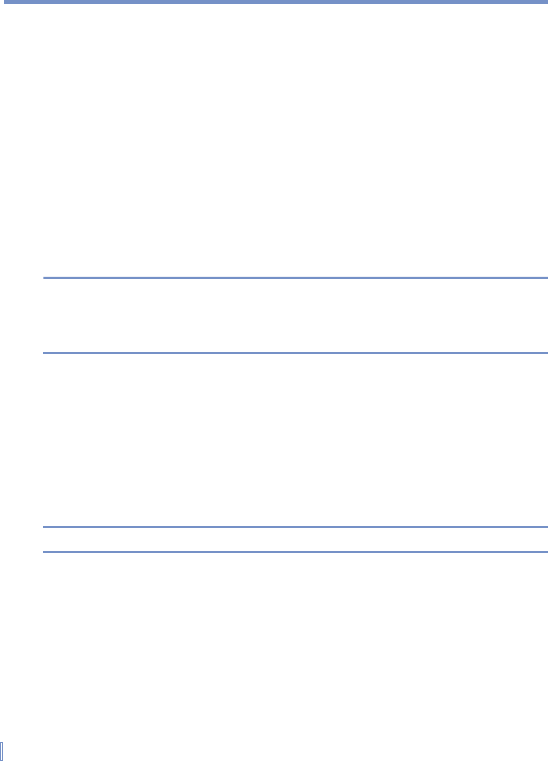
82 | Exchanging Messages and Using Outlook
6.5 Tasks
Use Tasks to keep track of things you need to do. A task can occur
once or repeatedly (recurring). You can set reminders for your tasks
and you can organize them using categories.
Your tasks are displayed in a task list. Overdue tasks are displayed in
red.
To create a task
1.
Tap
Start
>
Programs
> Tasks.
2.
Tap
New
, enter a subject for the task, and fi ll in information such
as start and due dates, priority, and so on.
3.
When fi nished, tap
OK
.
Tip You can easily create a short, to-do-type task. Simply tap the Tap here
to add a new task box, enter a subject, and press ENTER. If the task
entry box is not available, tap Menu > Options and select the Show
Tasks entry bar check box.
To change the priority of a task
Before you can sort tasks by priority, you need to specify a priority level
for each task.
1.
Tap
Start
>
Programs
>
Tasks
.
2.
Tap the task you want to change the priority for.
3.
Tap
Edit
and in the
Priority
box, tap a priority level.
4.
Tap
OK
to return to the task list.
Note All new tasks are assigned a Normal priority by default.

Exchanging Messages and Using Outlook | 83
To set a default reminder for all new tasks
You can have a reminder automatically turned on for all new tasks you
create.
1.
Tap
Start
>
Programs
>
Tasks
.
2.
Tap
Menu
>
Options
.
3.
Select the
Set
reminders
for
new
items
check box.
4.
Tap
OK
to return to the task list.
Note The new tasks must have due dates set in order for the reminder to take
effect.
To show start and due dates in the task list
1.
Tap
Start
>
Programs
>
Tasks
.
2.
Tap
Menu
>
Options
.
3.
Select the
Show start and due dates
check box.
4.
Tap
OK
.
To locate a task
When your list of tasks is long, you can display a subset of the tasks or
sort the list to quickly find a specific task.
1.
Tap
Start
>
Programs
>
Tasks
.
2.
In the task list, do one of the following:
•
Sort the list. Tap
Menu
>
Sort by
, and tap a sort option.
•
Filter the list by category. Tap
Menu
>
Filter
, and tap the
category you want displayed.
Tip To filter your tasks further, tap Menu > Filter > Active Tasks or
Completed Tasks.

84 | Exchanging Messages and Using Outlook
6.6 Notes
Notes helps you to quickly capture thoughts, questions, reminders,
to-do lists, and meeting notes. You can create handwritten and typed
notes, record voice notes, convert handwritten notes to text for easy
readability, and send notes to others.
Entering information in Notes
There are several ways to enter information in a note. You can enter
typed text by using the on-screen keyboard or handwriting recognition
software. You can also use the stylus to write or draw directly on the
screen. On devices that support recording, you can create a stand-
alone recording or embed a recording in a note.
To set the default input mode for Notes
If you frequently add drawings to your notes, you may find it helpful to
set Writing as the default input mode. If you prefer typed text, select
Typing.
1.
Tap
Start
>
Programs
>
Notes
.
2.
In the note list, tap
Menu
>
Options
.
3.
In the
Default mode
box, tap one of the following:
•
Writing
if you want to draw or enter handwritten text in a note.
•
Typing
if you want to create a typed note.
4.
Tap
OK
.
To create a note
1.
Tap
Start
>
Programs
>
Notes
.
2.
In the note list, tap
New
.
3.
Tap the
Input Selector
arrow next to the Input Method icon on
Input Selector arrow next to the Input Method icon on Input Selector
the menu bar, tap the input method you want, and enter your text.
4.
If the
Input Selector
arrow is not displayed, tap the Input Method
Input Selector arrow is not displayed, tap the Input Method Input Selector
icon.
5.
When fi nished, tap
OK
to return to the note list.
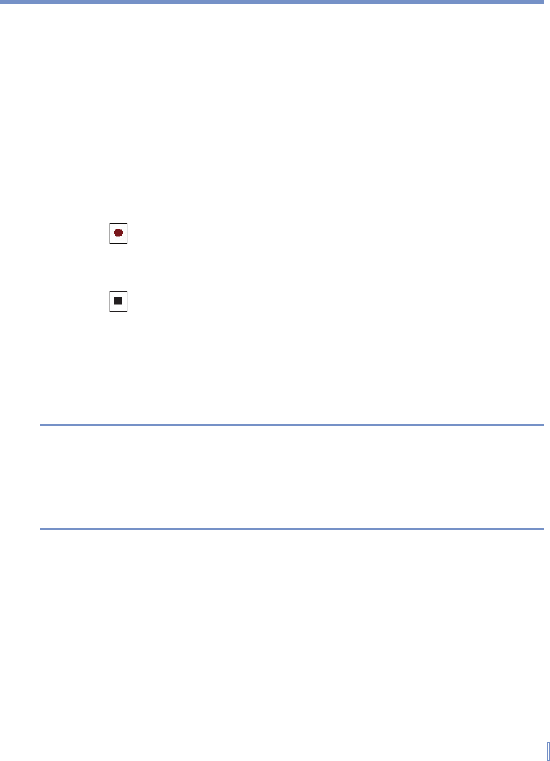
Exchanging Messages and Using Outlook | 85
To record a note
You can create a stand-alone recording (voice note) or you can add a
recording to a note.
1.
Tap
Start
>
Programs
>
Notes
.
2.
Do one of the following:
•
To create a stand-alone recording, record from the note list.
•
To add a recording to a note, create or open a note.
3.
If you do not see the
Recording
toolbar, tap
Menu
>
View
Recording Toolbar
.
4.
Tap
to begin recording.
5.
Hold your device’s microphone near your mouth or other source
of sound.
6.
Tap
when fi nished recording.
7.
When fi nished, tap
OK
to return to the note list.
If you are recording in an open note, an icon will appear in the
note.
If you are creating a stand-alone recording, an icon will appear in
the note list.
Note To play a recording, tap the Recording icon in the open note or tap the
recording in the note list.
Tip To quickly create a recording, press the RECORD hardware button.
When you hear the beep, begin your recording. Release the button
when you are finished.

86 | Exchanging Messages and Using Outlook

7.1 Using Pictures & Videos
7.2 Using Windows Media Player
Chapter 7
Experiencing Multimedia
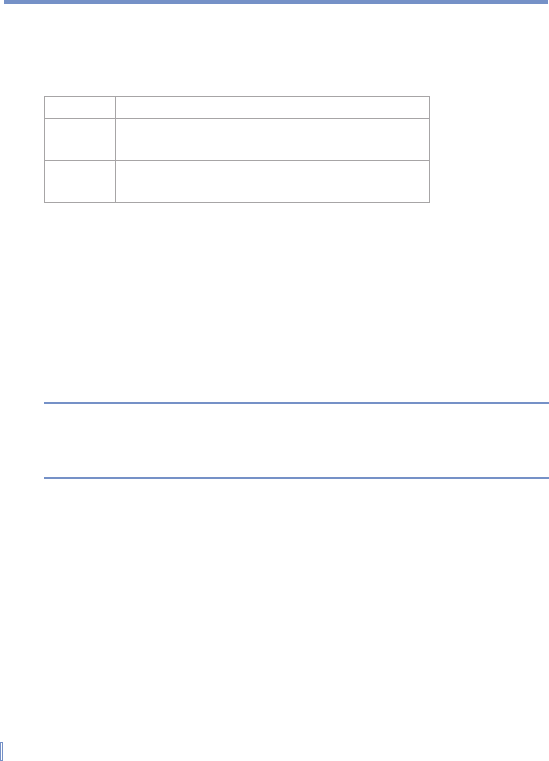
88 | Experiencing Multimedia
7.1 Using Pictures & Videos
The Pictures and Videos program collects, organizes, and sorts images
and video clips in the following formats on your device.
File Type
File
Extensions
Image .bmp
.jpg
Video .wmv
You can view the pictures as a slide show, bean them, send them via
e-mail, edit them, or set them as the background on the Today screen.
To copy a picture or video clip to your device
You can copy pictures from your PC
and view them on your device.
•
Copy the pictures from your PC or a storage card to the My
Pictures folder on your device.
For more information about copying files from your PC to your device,
see ActiveSync Help on your PC.
Note You can also copy pictures from your PC to your device using a memory
card. Insert the memory card into the memory card slot on your device,
and then copy the pictures from your PC to the folder you created on
the memory card.
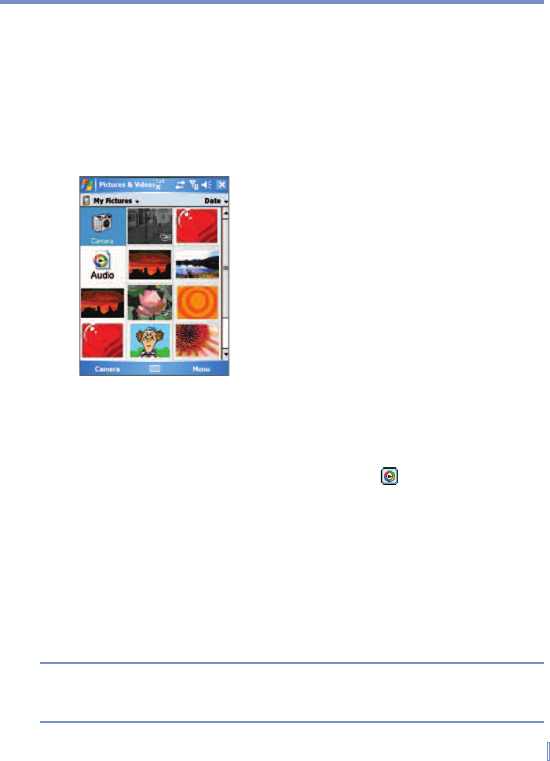
Experiencing Multimedia | 89
To view pictures
1.
Tap
Start
>
Programs
>
Pictures & Videos
.
The images in the My Pictures folder appear as thumbnails by
default.
2.
Select a picture and tap
View
.
If you cannot find a picture in the default My Pictures folder, go to
another folder by tapping the Down arrow.
Pictures and Videos
To play videos with audio
1.
Tap
Start
>
Programs
>
Pictures & Videos
.
The videos in the My Pictures folder appear as thumbnails by
default, while the audio files appear with a
icon.
2.
Select a video and tap the thumbnail to play it with the built-in
Windows Media Player.
To view slideshows
You can view your pictures as a slide show on your device. Pictures
are shown in full-screen view with 5-second intervals between slides.
1.
Tap
Start
>
Programs
>
Pictures & Videos
.
2.
Tap
Menu
>
Play Slide Show
.
Note You can specify how pictures are scaled to optimize their display in
a slide show. Tap Menu > Options and on the Slide Show tab, tap
Portrait Pictures or Landscape Pictures.

90 | Experiencing Multimedia
Tap anywhere on the screen to display the Slide Show toolbar, which
you can use to stop or pause the slide show, rotate the view, and more.
Press NAVIGATION right or left to move forward or backward through
the slides.
To sort pictures and video clips
If you store a large number of pictures or video clips on your device,
you may find it helpful to sort them to quickly find a specific picture or
clip. You can sort by name, date, and size.
1.
Tap
Start
>
Programs
>
Pictures & Videos
.
2.
Tap the sort list (labeled Date by default), and select the item you
want to sort by.
To delete a picture or video clip
Do any of the following to remove a picture or a video clip:
•
Select a picture or video clip on the Pictures & Videos screen,
and tap
Menu
>
Delete
. Tap
OK
to confi rm the deletion.
•
Tap and hold the thumbnail of the picture you want to delete, and
tap
Delete
.
To edit a picture or video clip
You can rotate, crop, and adjust the brightness and color contrast of
your pictures.
1.
Tap
Start
>
Programs
>
Pictures & Videos
.
2.
Tap the picture you want to edit.
3.
Tap
Menu
>
Edit
, and do any of the following:
•
To rotate a picture 90 degrees, tap
Rotate
.
•
To crop a picture, tap
Menu
>
Crop
. Then, tap and drag to
select the area to crop. Tap outside the box to stop cropping.
•
To adjust the brightness and contrast levels of a picture, tap
Menu
>
Auto Correct
.
Note To undo an edit, tap Menu > Undo. To cancel all unsaved edits you
made to the picture, tap Revert to Saved.
To set a picture as the Today screen background

Experiencing Multimedia | 91
You can use a picture as the background on the Today screen.
1.
Tap
Start
>
Programs
>
Pictures & Videos
.
2.
Select the picture you want to set as the background.
3.
Tap
Menu
>
Set
as Today Background
.
4.
In
Transparency level
, select a higher percentage for a more
transparent picture, or a lower percentage for a more opaque
picture.
5.
Tap
OK
.
To send pictures and video clips via e-mail
You can send pictures and video clips to other devices via e-mail.
1.
First, set up Messaging to send and receive messages.
2.
From the program, select the item you want to send.
3.
Tap
Menu
>
Send
.
A new message is created with the item attached.
4.
Enter the recipient name and subject, and tap
Send
.
The message will be sent the next time you synchronize your
device.
Note Pictures and video clips are saved automatically before they are sent.
To beam a picture
You can beam a picture to your friends or a family member using
Infrared.
1.
Tap
Start
>
Programs
>
Pictures & Videos
.
2.
Select the picture you want to beam.
3.
Tap
Menu
>
Beam
.
4.
Select a device to beam the picture.
5.
Tap
OK
.

92 | Experiencing Multimedia
To assign pictures to contacts
You can assign a picture to a contact so that you can easily identify the
contact at any point of time.
1.
Tap
Start
>
Programs
>
Pictures & Videos
.
2.
Select the picture you want to assign to a contact.
3.
Tap
Menu
>
Save to Contact
.
4.
Tap the contact, or navigate and tap
Select
to choose the contact
from your Contacts list.
To use advance options
1.
Tap
Start
>
Programs
>
Pictures & Videos
.
2.
Select the picture for which you want to confi gure further settings.
3.
Tap
Menu
>
Options
.
The Options screen is displayed.
The Options screen allows you to do the following:
•
Resize a picture so that you can send it faster to someone
using your e-mails.
•
Configure the view settings during slide shows and activate
screensaver options.
•
Set the direction you want to rotate a picture 90 degrees.

Experiencing Multimedia | 93
7.2 Using Windows Media Player
You can use Microsoft Windows Media Player 10 Mobile for Pocket PC
to play digital audio and video files that are stored on your device or on
a network, such as on a Web site.
Using Windows Media Player, you can play both audio and video files.
These are the following file formats that are supported by this version
of Windows Media Player.
File Formats Supported
File
Extensions
Video
• Windows Media Video .wmv
Audio
• Windows Media Audio
• MP3
• MIDI
.wma
.mp3
.wav
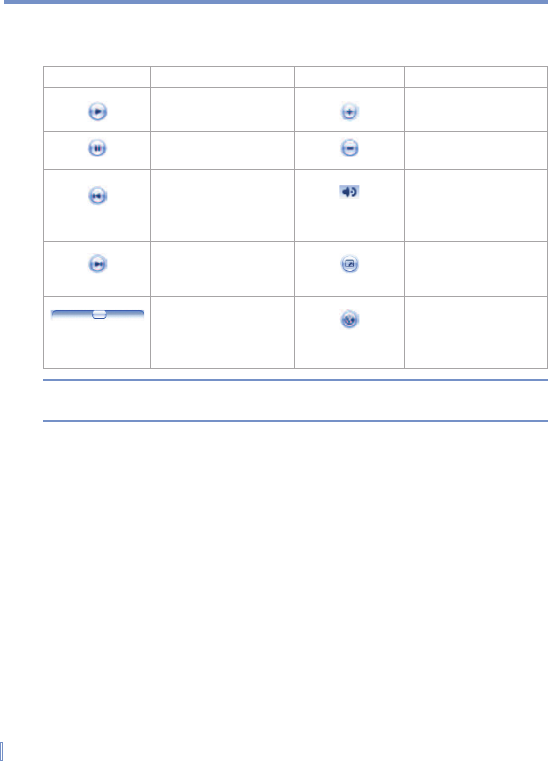
94 | Experiencing Multimedia
About the controls
The following are available controls on the Windows Media Player.
This control
Does this
This control
Does this
Plays a file. Increases the
volume level.
Pauses a file. Decreases the
volume level.
Skips to the
beginning of the
current file or to the
previous file.
Turns the sound on
or off.
Skips to the next file. Displays a video
by using the entire
screen (full screen).
Adjusts the playback
progress of a
selected file.
Displays a Web site
where you can find
music and videos
to play.
Note If your device hardware supports it, you can rewind and fast-forward
files by pressing and holding the Left/Right controls.
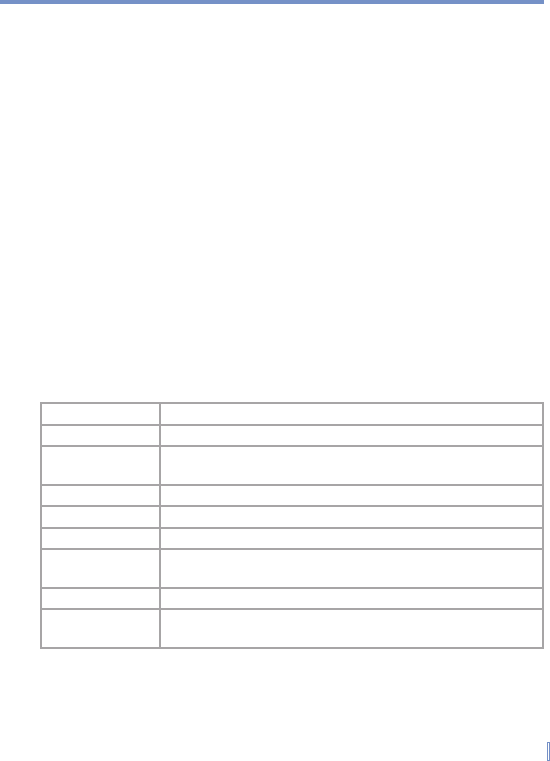
Experiencing Multimedia | 95
About the screens and menus
Windows Media Player has three primary screens:
Playback screen.
The default screen that displays the playback
controls (such as Play, Pause, Next, Previous, and Volume), the album
art window, and the video window. You can change the appearance of
this screen by choosing a different skin.
Now Playing screen.
The screen that displays the Now Playing
playlist. This special playlist indicates the currently playing file and any
files that are “queued up” to play next.
Library screen.
The screen that lets you quickly find your audio files,
video files, and playlists. It contains categories such as My Music, My
Video, My TV, and My Playlists.
At the bottom of each screen is a menu called
Menu
. The commands
on this menu change depending upon which screen you are viewing.
Playback screen menu
When you are viewing the Playback screen, the following commands
appear on
Menu
.
This control
Does this
Play/Pause Starts or pauses playback.
Shuffle/Repeat Plays the items in the Now Playing playlist repeatedly or
randomly.
Stop Stops playback.
Full Screen
When a video is playing, displays it by using the entire screen.
Library
Displays the Library screen so you can choose a file to play.
Options Lets you adjust various Windows Media Player options,
including network, skin, and hardware button options.
Properties Displays information about the currently playing file.
About Displays information about Windows Media Player, such as
the version number.
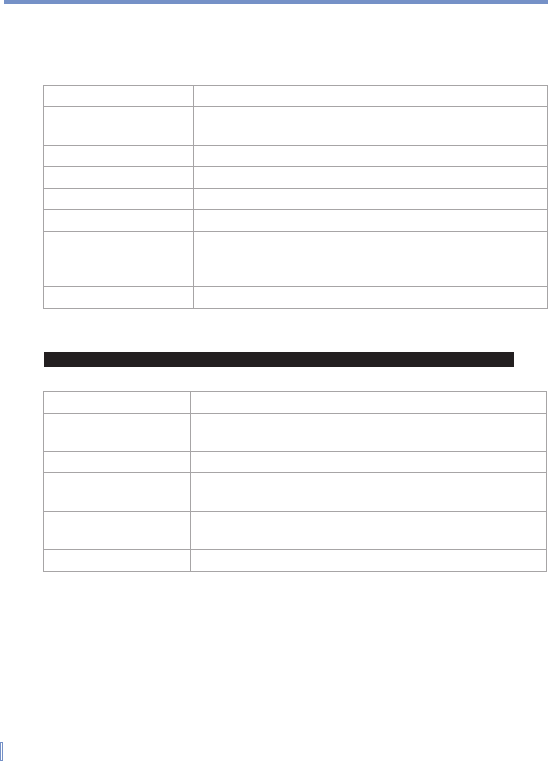
96 | Experiencing Multimedia
Now Playing screen menu
When you are viewing the Now Playing screen, the following
commands appear on
Menu
.
This control
Does this
Library Displays the Library screen so you can choose a file
to play.
Move Up Moves the selected item up in the playlist order.
Move Down Moves the selected item down in the playlist order.
Remove from Playlist
Deletes the selected item from the playlist.
Clear Now Playing Deletes all items from the Now Playing playlist.
Error Details Displays error information about the selected item (an
exclamation mark appears before the item name if
error details are available).
Properties Displays information about the selected file.
Library screen menu
When you are viewing the Library screen, the following commands
appear on
Menu
.
This
command
Does this
Queue Up Adds the selected item to the end of the current (Now
Playing) playlist.
Delete from Library MDeletes the selected item from the library.
Update Library Adds new items to the library by searching your device
or storage card.
Open File Lets you find and play files that are stored on your
device or storage card but that are not in the library..
Properties Displays information about the selected file.
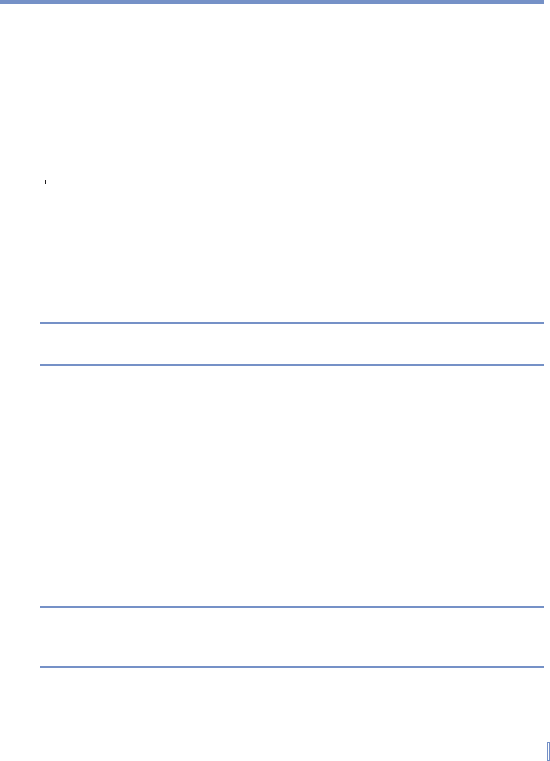
Experiencing Multimedia | 97
About licenses and protected files
Some content (such as digital media files downloaded from the
Internet, CD tracks, and videos) have associated licenses that protect
them from being unlawfully distributed or shared. Licenses are created
and managed by using digital rights management (DRM), which is the
technology for securing content and managing its access rights. Some
licenses may prevent you from playing files that have been copied to
your device. Files that have licenses associated with them are called
“
protected files
“protected files“
.
”
If you want to copy a protected file from your PC to your device, use
the desktop Player to synchronize the file to your device (instead of
dragging the file from a folder on your PC to a folder on your device,
for example). This will ensure that the license is copied along with the
protected file. For more information about synchronizing files to your
device and other mobile devices, see desktop Player Help.
Note You can view the protection status for a file by checking its file
properties (tapping Menu > Properties).
To play items on your device
Use the library to find and play songs, videos, and playlists that are
stored on your device or removable storage card.
1.
If you are not on the Library screen, tap
Menu
>
Library
.
2.
On the Library screen, tap the Library arrow (near the top of the
screen), and then tap the library that you want use (for example,
My Device or Storage Card).
3.
Tap a category (for example, My Music or My Playlists), tap and
hold the item that you want to play (such as a song, album, or
artist name), and then tap
Play
.
Note To play a file that is stored on your device but is not in a library, on the
Library screen, tap Menu > Open File. Tap and hold the item that you
want to play (such as a file or a folder), and then tap Play.
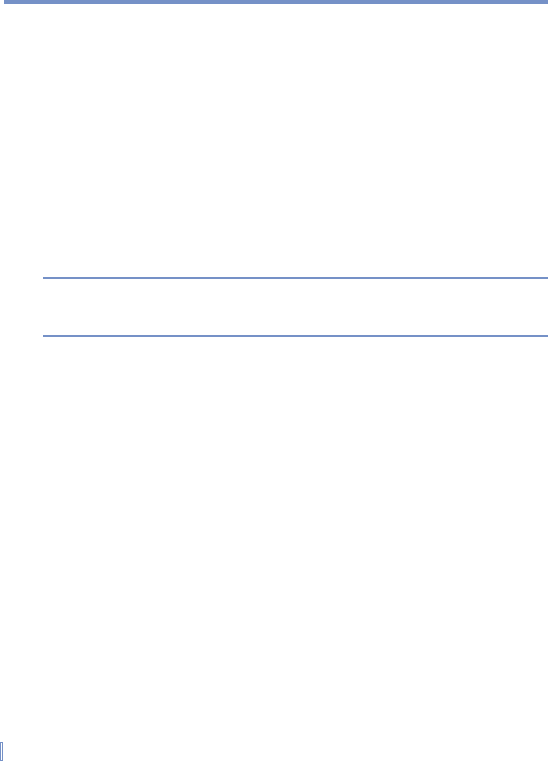
98 | Experiencing Multimedia
Copy files to your device
Use the latest version of the desktop Player (Windows Media Player
10 or later) to synchronize digital media files to your device (instead of
dragging a file from a folder on your PC to a folder on your device, for
example). Using the desktop Player ensures that licenses are copied
with protected files.
When synchronizing files, always synchronize the files to a storage
card that is inserted into your device. Do not synchronize to a storage
card that is inserted into a storage card reader. In addition, do not
synchronize to the internal storage location (RAM) in your device.
For more information about synchronizing files to mobile devices, see
desktop Player Help on the PC.
Note Audio files copy faster if the desktop Player is configured to
automatically set the quality level for audio files copied to your device.
For more information, see desktop Player Help on the PC.
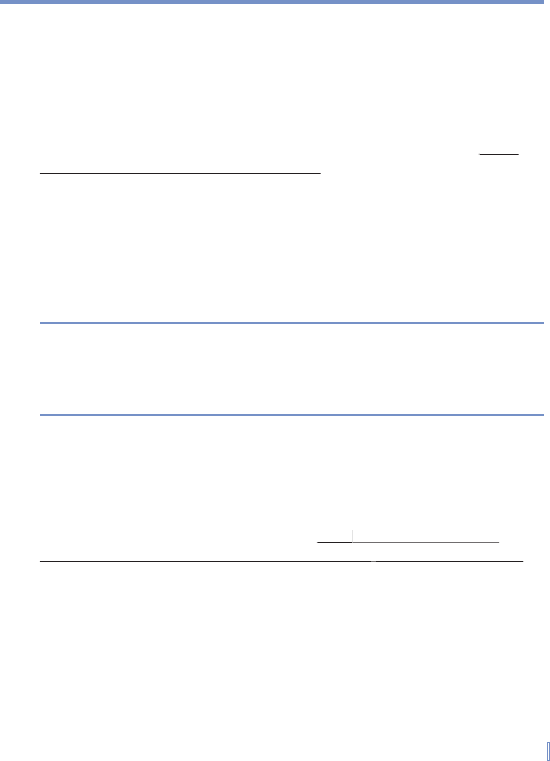
Experiencing Multimedia | 99
Accessibility for people with disabilities
Microsoft is committed to making its products and services easier
for everyone to use. Many accessibility features have been built into
Microsoft products, including features for individuals who have difficulty
typing or using a mouse, who are blind or have low vision, or who
are deaf or hard-of-hearing. For more information about the following
topics, see the Accessibility section of the Microsoft Web site (
http://
http://
www.microsoft.com/enable/default.aspx
www.microsoft.com/enable/default.aspx
).
•
Accessibility in Microsoft Windows
•
Adjusting Microsoft products for people with accessibility needs
•
Free step-by-step tutorials
•
Microsoft documentation in alternative formats
•
Assistive technology for Windows
•
Customer service for people who are deaf or hard-of-hearing
Note The information in this section applies to users who license Microsoft
products in the United States. If you obtained this product outside the
United States, your package contains a subsidiary information card that
you can use to contact your subsidiary about the products and services
available in your area.
Troubleshooting
If you encounter a problem while using the Windows Media Player, a
number of resources are available to help you troubleshoot the issue.
For more information, see the Troubleshooting Windows Media Player
Mobile page at the Microsoft Web site (
http:/
http:/
/w
http://whttp:/
ww.microsoft.com/
windows/windowsmedia/player/windowsmobile
windows/windowsmedia/player/windowsmobile
/
troubleshooting.aspx
troubleshooting.aspx
).

100 | Experiencing Multimedia

8.1 Word Mobile
8.2 Excel Mobile
8.3 Viewing Slide Shows
with PowerPoint Mobile
Chapter 8
Using Other Applications

102 | Using Other Applications
8.1 Word Mobile
Word Mobile is a streamlined version of Microsoft Word. Word
documents created on your PC can be opened and edited on your
device. You can also create and edit documents and templates in Word
Mobile and save them as .doc, .rtf, .txt, and .dot files.
You can have only one document open at a time. When you open a
second document, the first one is saved and closed automatically.
When you close a newly created document, it is automatically named
after the first several words in the document and placed in the Word
Mobile document list. You can easily rename the document with a more
meaningful name and move it to another folder or a storage card.
To create a fi le
1.
In Word Mobile, tap
New
.
2.
You will see either a blank document or template, depending on
what you have selected as the default template.
3.
Enter text as desired.
4.
When fi nished, tap
OK
to save the fi le.
Unsupported features in Word Mobile
Word Mobile does not fully support some features of Microsoft Word,
such as revision marks and password protection. Some data and
formatting may be lost when you save the document on your device.
The following features are not supported in Word Mobile.
•
Backgrounds
•
Shapes and text boxes
•
Artistic page borders
•
Smart tags
•
Metafi les

Using Other Applications | 103
•
Bi-directional text
. While Word Mobile will open documents
containing bi-directional text, the indentations and alignment may
be displayed and saved incorrectly.
•
Password-protected fi les
. Word Mobile does not support
opening password-protected documents. You must fi rst remove
the password protection in Word on the PC if you want to view
the document on the device.
•
Document protection
.Word Mobile does not support displaying
fi les that have been protected in Word on the PC.
The following features are partially supported in Word Mobile.
•
Picture bullets
•
Revision marks
•
Table styles
•
Underline styles
. Underline styles not supported by Word Mobile
are mapped to one of the four supported styles: regular, dotted,
wavy, or thick/bold/wide.
•
Legacy Pocket Word fi les
. You can open *.psw fi les in Word
Mobile; however, if you edit a fi le, you will need to save it in *.doc,
*.rtf, *.txt, or *.dot format.
The following features are not supported on the device; however, they
are retained in the file so that when a file is opened on the PC again,
they appear as expected.
•
Footnotes, endnotes, headers, footers
•
Page breaks
•
Lists
•
Fonts and font sizes
. Fonts not supported by the device are
mapped to the closest font available, although the original font
will be listed on the device.

104 | Using Other Applications
To get more help about Word Mobile
•
From within Word Mobile, tap
Start
>
Help
.
8.2 Excel Mobile
Excel Mobile makes it easy for you to open and edit Excel workbooks
and templates created on your PC. You can also can create new
workbooks and templates on your device.
Tips Work in full-screen mode to see as much of your workbook as possible.
Tap View > Zoom and select a percentage so that you can easily read
the worksheet.
Unsupported features in Excel Mobile
Excel Mobile does not fully support some features such as formulas
and cell comments. Some data and formatting may be lost when you
save the workbook on your device. Note the following Excel Mobile
formatting considerations:
•
Alignment
. Horizontal, vertical, and wrap-text attributes remain
the same, but vertical text appears horizontal.
•
Borders
. Appear as a single line.
•
Cell patterns
. Patterns applied to cells are removed.
•
Fonts and font sizes
. Fonts not supported by your device are
mapped to the closest font available. The original font is listed on
your device. When the workbook is opened in Excel on your PC
again, the data is displayed in the original font.
•
Number formats
. Numbers formatted using the Microsoft Excel
97 conditional formatting feature are displayed in Number format.
•
Formulas and functions
. If an Excel fi le contains a function
that is not supported by Excel Mobile, the function is removed,
and only the returned value of the function appears. The
following formulas are also converted to values: formulas entered

Using Other Applications | 105
as an array or containing an array argument, for example,
=SUM({1;2;3;4}); formulas containing external link references
or an intersection range reference; and formulas containing
references past row 16384 are replaced with #REF!
•
Protection settings
. Most worksheet and workbook protection
features are disabled but not removed. However, support
for password protection has been removed. Workbooks that
are password-protected or workbooks in which one or more
worksheets are password-protected cannot be opened. You must
remove the password protection in Excel on the PC and then
synchronize to open the fi le on the device.
•
Zoom settings
. Are not retained. Excel supports a per worksheet
zoom setting, while the Excel Mobile zoom setting is applied to
the entire workbook.
•
Worksheet names
. Names that reference worksheets ithin the
same workbook are displayed accurately, but names that refer to
other workbooks, arrays, for example, ={1;2;3;4}, array formulas,
or intersection ranges are removed from the name list. If a
name is removed from the list, it is left in formulas and functions,
causing those formulas to be resolved as “#NAME?” All hidden
names are not hidden.
•
AutoFilter settings
. Are removed. However, you can use the
AutoFilter
command in Excel Mobile to perform similar functions.
AutoFilter command in Excel Mobile to perform similar functions. AutoFilter
If you have an AutoFilter applied to a worksheet that causes rows
to be hidden, the rows remain hidden when the fi le is opened in
Excel Mobile. Use the
Unhide
command to display the hidden
rows.
•
Chart formatting
. All charts will be saved the way they are
shown in Excel Mobile. Unsupported chart types are changed to
one of these supported types: Column, Bar, Line, Pie, Scatter,
and Area. Background colors, gridlines, data labels, trend lines,
shadows, 3D effects, secondary axes, and logarithmic scales are
turned off.

106 | Using Other Applications
•
Worksheet features
. The following features are not supported
in Excel Mobile and are removed or modifi ed when a workbook
is opened on the device: hidden sheets are not hidden; VBA
modules, macro sheets, and dialog sheets are removed and
replaced with a place holder sheet; text boxes, drawing objects,
pictures, lists, conditional formats, and controls are removed;
pivot table data is converted to values.
To get more help about Excel Mobile
•
From within Excel Mobile, tap
Start
>
Help
.
8.3 Viewing Slide Shows with
PowerPoint Mobile
With PowerPoint Mobile, you can open and view slide show
presentations created on your PC in *.ppt and *.pps format with
PowerPoint '97 and later.
Many presentation elements built into the slide shows such as
slide transitions and animations will play back on the device. If the
presentation is set up as a timed slide show, one slide will advance to
the next automatically. Links to URLs are also supported.
PowerPoint features not supported on the device include:
•
Notes. Notes written for slides will not be visible.
•
Rearranging or editing slides. PowerPoint Mobile is a viewer only.
•
File formats. Files created in *.ppt format earlier than PowerPoint
'97 and HTML fi les in *.htm and *.mht formats are not supported.
To start a slide show presentation
1.
Tap
Start
>
Programs
>
PowerPoint Mobile
.
2.
In the presentation list, tap the slide show you want to view.
3.
Tap the current slide to advance to the next slide.
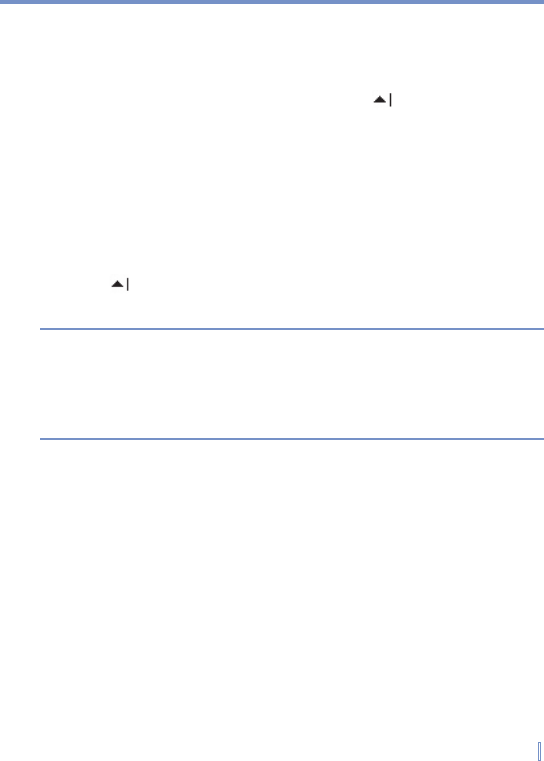
Using Other Applications | 107
If the presentation is set up as a timed slide show, slides will advance
automatically.
To stop a slide show
•
In a PowerPoint Mobile presentation, tap
>
End Show
.
To navigate between slides
You can advance to the next slide if a presentation is not set up as a
timed slide show, return to the previous slide, or go to any slide out of
sequence.
1.
Tap
Start
>
Programs
>
PowerPoint
Mobile
.
2.
Open the presentation you want to view.
3.
Tap
>
Next
or
Previous
, or tap
Go
to Slide
and tap the the
slide you want to view.
Notes If you have zoomed in to see a slide in more detail, you cannot navigate
to another slide until you zoom out.
Tapping Next or Previous may play an animation on a slide rather than
navigate to another slide.
Tip Simply tap the current slide to go to the next one.

108 | Using Other Applications

A.1 Regulatory Notices
A.2 PC Requirement to Run ActiveSync 4.x
A.3 Specifications
A.4 Index
Appendix

110 | Appendix
A.1 Regulatory Notices
Regulatory Agency IDs
For regulatory identification purposes, your product is assigned a
model number of GALA100.
To ensure continued reliable and safe operation of your device, use
only the accessories listed below with your GALA100.
The Battery Pack has been assigned a model number of GALA160.
This product is intended for use with a certified Class 2 Limited Power
Source, rated 5 Volts DC, maximum 1 Amp power supply unit.
European Union Notice
Products with CE marking comply with the R&TTE Directive (99/5/
EC), the EMC Directive (89/336/EEC), and the Low Voltage Directive
(73/23/EEC) issued by the Commission of the European Community.
Compliance with these directives implies conformity to the following
European Norms (in parentheses are the equivalent international
standards).
•
EN 60950-1 (IEC 60950-1)
Safety of InformationTechnology Equipment.
•
ETSI EN 301 489-1
Electromagnetic compatibility and Radio spectrum Matters
(ERM); ElectroMagnetic Compatibility (EMC) standard for radio
equipment and services; Part 1: Common technical requirements.
•
ETSI EN 301 489-17
Electromagnetic compatibility and Radio spectrum Matters
(ERM); ElectroMagnetic Compatibility (EMC) standard for radio
equipment and services; Part 17: Specifi c conditions for 2.4 GHz
wideband transmission systems and 5 GHz high performance
RLAN equipment.AccessoriesModel NumberCradlePH15x
•
ETSI EN 300 328
Electromagnetic compatibility and Radio spectrum Matters
(ERM); Wideband Transmission systems; data transmission

Appendix | 111
equipment operating in the 2.4 GHz ISM band and using spread
spectrum modulation techniques.
•
EN 50371:2002
Generic standard to demonstrate the compliance of low power
electronic and electrical apparatus with the basic restrictions
related to human exposure to electromagnetic fields (10 MHz
- 300 GHz) - General public
Federal Communications Commission Notice
This equipment has been tested and found to comply with the limits for
a Class B digital device, pursuant to Part 15 of the FCC Rules. These
limits are designed to provide reasonable protection against harmful
interference in a residential installation. This equipment generates,
uses, and can radiate radio frequency energy and, if not installed
and used in accordance with the instructions, may cause harmful
interference to radio communications. However, there is no guarantee
that interference will not occur in a particular installation. If this
equipment does cause harm-ful interference to radio or TV reception,
which can be determined by turning the equipment on and off, the user
is encouraged to try to correct the interference by one or more of the
following measures:
•
Reorient or relocate the receiving antenna.
•
Increase the separation between the equipment and receiver.
•
Connect the equipment into an outlet on a circuit different from
that to which the receiver is connected.
•
Consult the dealer or an experienced radio or television
technician for help.
This device complies with Part 15 of the FCC Rules.
Operation is subject to the following two conditions:
(1)
This device may not cause harmful interference, and
(2)
This device must accept any interference received, including
interference that may cause undesired operation.
This device and its antenna(s) used for this transmitter must not be
co-located or operating in conjunction with any other antenna or
transmitter.

112 | Appendix
Modifications
The FCC requires the user to be notified that any changes or
modifications made to the device that are not expressly approved
by High Tech Computer Corporation may void the user’s authority to
operate the equipment.
Important Health and Safety Information
Retain and follow all product safety and operating instructions. Observe
all warnings in the operating instructions on the product.
To reduce the risk of bodily injury, electric shock, fire, and damage to
the equipment, observe the following precautions.
Safety Precautions for RF Exposure
Tests for SAR are conducted using standard operating positions
specified by the FCC with the device transmitting at its highest certified
power level in all tested frequency bands. Although the SAR is
determined at the highest certified power level, the actual SAR level of
the device while operation can be well below the maximum value. This
is because the device is designed to operate at multiple power levels
so as to use only the power required to reach the network. In general,
the closer you are to a wireless base station antenna, the lower the
power output. Before a model is available for sale to the public, it must
be tested and certified to the FCC that it does not exceed the limit
established by the government-adopted requirement for safe exposure.
The tests are performed in positions and locations (for example, at the
ear and worn on the body) as required by the FCC for each model.
(Body-worn measurements may differ among models, depending
upon available accessories and FCC requirements). For body worn
operation, to maintain compliance with FCC RF exposure guidelines,
use only original manufacturer approved accessories. When carrying
the device while it is on, use the specific original manufacturer supplied
or approved carrying case, holster, or other body-worn accessory.
General Precautions
•
Heed service markings
Except as explained elsewhere in the Operating or Service

Appendix | 113
documentation, do not service any product yourself. Service
needed on components inside these compartments should be
done by an authorized service technician or provider.
•
Damage requiring service
Unplug the product from the electrical outlet and refer servicing to
an authorized service technician or provider under the following
conditions:
•
Liquid has been spilled or an object has fallen into the
product.
•
The product has been exposed to rain or water.
•
The product has been dropped or damaged.
•
There are noticeable signs of overheating.
•
The product does not operate normally when you follow the
operating instructions.
•
Avoid hot areas
The product should be placed away from heat sources such as
radiators, heat registers, stoves, or other products (including
amplifi ers) that produce heat.
•
Avoid wet areas
Never use the product in a wet location.
•
Avoid pushing objects into product
Never push objects of any kind into cabinet slots or other
openings in the product. Slots and openings are provided for
ventilation. These openings must not be blocked or covered.
•
Mounting Accessories
Do not use the product on an unstable table, cart, stand,
tripod, or bracket. Any mounting of the product should follow
the manufacturer’s instructions, and should use a mounting
accessory recommended by the manufacturer.
•
Avoid unstable mounting
Do not place the product with an unstable base.
•
Use product with approved equipment
This product should be used only with personal computers and

114 | Appendix
options identifi ed as suitable for use with your equipment.
•
Adjust the volume
Turn down the volume before using headphones or other audio
devices.
•
Cleaning
Unplug the product from the wall outlet before cleaning. Do not
use liquid cleaners or aerosol cleaners. Use a damp cloth for
cleaning, but NEVER use water to clean the LCD screen.
Safety Precautions for Power Supply Unit
•
Use the correct external power source
A product should be operated only from the type of power source
indicated on the electrical ratings label. If you are not sure of the
type of power source required, consult your authorized service
provider or local power company. For a product that operates
from battery power or other sources, refer to the operating
instructions that are included with the product.
•
Handle battery packs carefully
This product contains a Li-Ion battery. There is a risk of fi re and
burns if the battery pack is handled improperly. Do not attempt
to open or service the battery pack. Do not disassemble, crush,
puncture, short external contacts or circuits, dispose of in fi re or
water, or expose a battery pack to temperatures higher than 60
˚
C
(140
˚
F
).
Exposure to Radio Frequency (RF) Signals
Your wireless device is a radio transmitter and receiver. It is designed
and manufactured not to exceed the emission limits for exposure
to radio frequency (RF) energy set by the Federal Communications
Commission of the U.S. Govern-ment. These limits are part of
comprehensive guidelines and establish permitted levels of RF energy
for the gen-eral population. The guidelines are based on the safety
standards previously set by both U.S. and international standards
bodies:
• American National Standards Institute (ANSI) IEEE. C95.1-1992
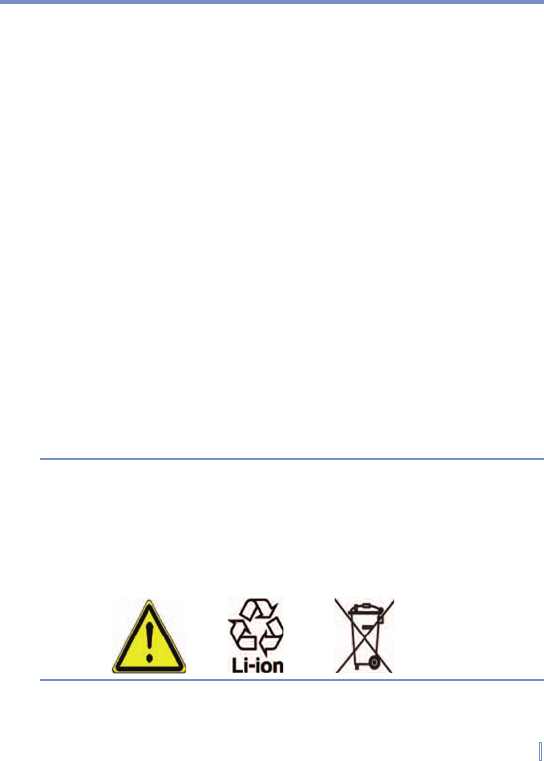
Appendix | 115
• National Council on Radiation Protection and Measure-ment (NCRP).
Report 86. 1986
• International Commission on Non-Ionizing Radiation Protection
(ICNIRP) 1996
• Ministry of Health (Canada), Safety Code 6. The standards include a
substantial safety margin designed to assure the safety of all persons,
regardless of age and health.
In the U.S. and Canada, the SAR limit for portable devices used by the
public is 1.6 Watts/kg (W/kg) averaged over one gram of tissue. The
standard incorporates a substantial margin of safety to give additional
protection for the public and to account for any variations in usage.
Normal condi-tions only ensure the radiative performance and safety
of the interference. As with other mobile radio transmitting equip-ment,
users are advised that for satisfactory operation of the equipment
and for the safety of personnel, it is recommended that no part of
the human body be allowed to come too close to the antenna during
operation of the equipment.
SAR Information
SAR(1g) = 0.460mW/g; SAR(10g) = 0.221mW/g.
Warning! DANGER OF EXPLOSION IF BATTERY IS INCORRECTLY
REPLACED. TO REDUCE RISK OF FIRE OR BURNS, DO NOT
DISASSEMBLE, CRUSH, PUNCTURE, SHORT EXTERNAL
CONTACTS, EXPOSE TO TEMPERATURE ABOVE 60˚C (140˚F),
OR DISPOSE OF IN FIRE OR WATER. REPLACE ONLY WITH
SPECIFIED BATTERIES. RECYCLE OR DISPOSE OF USED
BATTERIES ACCORDING TO THE LOCAL REGULATIONS
OR REFERENCE GUIDE SUPPLIED WITH YOUR PRODUCT.

116 | Appendix
A.2 PC Requirement to Run ActiveSync 4.x
To connect your device to the PC, you have to installed Microsoft®
ActiveSync® program on your PC. ActiveSync 4.0 is included in
the Installation CD, which is compatible with the following operating
systems and applications:
• Microsoft® Windows® 2000 Service Pack 4
• Microsoft® Windows® Server 2003 Service Pack 1
• Microsoft® Windows® Server 2003 IA64 Edition Service Pack 1
• Microsoft® Windows® Server 2003 x64 Edition Service Pack 1
• Microsoft® Windows® XP Professional Service Packs 1 and 2
• Microsoft® Windows® XP Home Service Packs 1 and 2
• Microsoft® Windows® XP Tablet PC Edition 2005
• Microsoft® Windows® XP Media Center Edition 2005
• Microsoft® Windows® XP Professional x64 Edition
• Microsoft® Outlook® 98, Microsoft® Outlook® 2000 and Microsoft® Outlook®
XP, and Microsoft® Outlook® 2003 messaging and collaboration clients
• Microsoft® Office 97, excluding Outlook
• Microsoft® Office 2000
• Microsoft® Office XP
• Microsoft® Office 2003
• Microsoft® Internet Explorer 4.01 or later (required)
• Microsoft® Systems Management Server 2.0
A.3 Specifications
System Information
Processor S3C2440M 300Mhz
Memory - ROM : 64 MB
- RAM : 32 MB SDRAM
Operating System Windows MobileTM Version 5.0
Display
LCD Type 2.8” transflective TFT-LCD with back-light LEDs,
touch-sensitive screen
Resolution 240 x 320 with 65,536 colors
Alignment Support
Portrait and Landscape
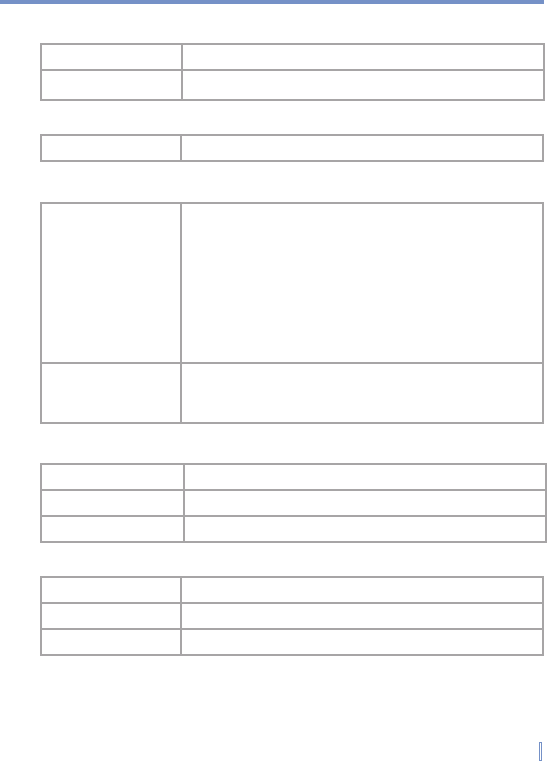
Appendix | 117
Physical
Dimensions 109.7mm (L) x 59.4mm (W) x 17.6mm (T)
Weight 150g (with battery)
Expansion Slots
MMC Card Yes
Controls and Lights
Navigation
Buttons
5-way navigation pad
- Voice record button
- GPS Launch key
- Outlook Email launch button (If GPS is not equipped)
- Today button
- OK button (If GPS is not equipped)
- Right and left softkeys
- Power On/Off and Backlight button
- Reset switch
LED One Bi-color LED for PDA notification and charging
status. Another Tri-color LED for indicating Bluetooth
(Blue) / Wi-Fi (Green) and GPS (Orange) status.
Audio
Audio Controller AGC
Microphone/Speaker
Built-in/Dual, Hands-free
Headphone WAV/WMA/MP3 codec
Connection
Infrared IrDA SIR
I/O port USB, Mini-SD card slot
Audio Stereo earphone/microphone jack

118 | Appendix
A.4 Index
A
Accessibility
9
9
ActiveSync
3
1
Adding and Removing Programs
4
5
Appointment search
2
8
Audio
11
7
B
Backing Up Files
4
8
Battery
1
5
Beaming Information
6
2
Bluetooth
3
4
Bluetooth partnership
6
0
C
Calendar
7
8
Calendar search
2
8
Calibration
1
7
Charging Battery
1
6
Connection
11
7
Connect to private network
5
4
Connect to Terminal Server
6
6
Contacts
8
0
Contacts search
2
8
Controls & Lights
11
7
Cookies, Security Settings (Internet
Explorer)
5
8
Copy media files
9
8
Copy pictures from a PC
8
8
Customizing the Start menu
3
9
D
Deleting pictures & videos
9
0
Desktop player
9
3
Digital Rights Management
9
7
Display
11
6
E
E-mail and Text Messages
7
0
E-mail search
2
8
Editing pictures & videos
9
0
Excel Mobile
10
4
Exchange Server
3
3
Expansion Slots
11
7
F
Favorites, transfering from PC
5
6
Favorites (Internet Explorer)
5
6
H
Help search
2
8
History list (Internet Explorer
5
7
Home page (Internet Explorer)
5
6
I
Images, showing on Web pages
5
7
Indicators
2
0
Infrared (IR)
3
4
Input Panel
2
6
Input Selector
2
6
Installing ActiveSync
3
1
Internet Explorer Mobile
5
6
Introduction
2
6

Appendix | 119
L
Library screen
9
5
Licensed media
9
7
M
Mail search
2
8
Managing Memory
4
7
Media synchronization settings
3
5
MSN Messenger
7
6
N
Notes
8
4
Notes search
2
8
Now Playing screen
9
5
O
On-Screen Keyboard
2
6
P
Password
5
0
Personal and system settings
4
1
Physical
11
7
Pictures, on Web pages
5
7
Playback screen
9
5
Playing videos
8
9
Play media
9
7
Pocket PC player
9
3
PowerPoint Mobile
10
6
Protected files
9
7
Protecting Your Device
5
0
R
Recording a Note
2
7
Regulatory Notices
11
0
S
Safety Information
11
2
Searching
2
8
Security Settings (Internet Explorer)
5
8
Sending pictures & videos
9
1
Setting Date / Time / Language /
Regional Options
3
9
Setting pictures as Today
backgrounds
9
0
Sorting pictures & videos
9
0
Specifications
11
6
Starting Up
1
7
Start WLAN Manager
6
4
Storage card
3
5
Synchronizing Information
3
1
Synchronizing music, video, and
pictures
3
5
Synchronizing via Infrared and
Bluetooth
3
4
Synchronizing with Exchange
Server
3
3
Sync Setup Wizard
3
1
System Information
11
6
T
Tasks
8
2
Tasks search
2
8
Temporary Internet files, deleting
(Internet Explorer)
5
8

120 | Appendix
Text size, Web pages
5
7
Today Screen
1
9
Today screen settings
3
8
Troubleshooting Windows Media
Player
9
9
Type text
2
6
U
Using ActiveSync
3
0
Using Bluetooth
5
9
Using Pictures & Videos
8
8
Using Start Menu
2
3
Using Terminal Services Client
6
6
V
Viewing pictures
8
9
Viewing slideshows
8
9
W
Web browsing (Internet Explorer)
5
6
Web pages, layout
5
7
Web pages, showing pictures on
5
7
Web pages, text size
5
7
Windows Media Player
3
5
,
9
3
Windows Media Player accessibility
9
9
Windows Media Player menus
9
5
Windows Media Player,
troubleshooting
9
9
Word Mobile
10
2

WEEE Notice
English .........................................................
The Directive on Waste Electrical and Electronic Equipment
(WEEE), which entered into force as European law on 13th
February 2003, resulted in a major change in the treatment of
electrical equipment at end-of-life.
The purpose of this Directive is, as a fi rst priority, the prevention of
WEEE, and in addition, to promote the reuse, recycling and other
forms of recovery of such wastes so as to reduce disposal.
The WEEE logo (
) on the product or on its box indicates that
this product must not be disposed of or dumped with your other
household waste. You are liable to dispose of all your electronic
or electrical waste equipment by relocating over to the specifi ed
collection point for recycling of such hazardous waste. Isolated
collection and proper recovery of your electronic and electrical
waste equipment at the time of disposal will allow us to help
conserving natural resources. Moreover, proper recycling of the
electronic and electrical waste equipment will ensure safety of
human health and environment. For more information about
electronic and electrical waste equipment disposal, recovery, and
collection points, please contact your local city centre, household
waste disposal service, shop from where you purchased the
equipment, or manufacturer of the equipment.